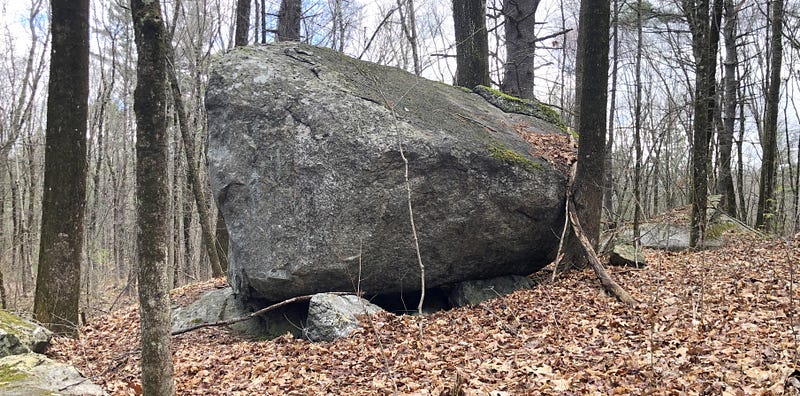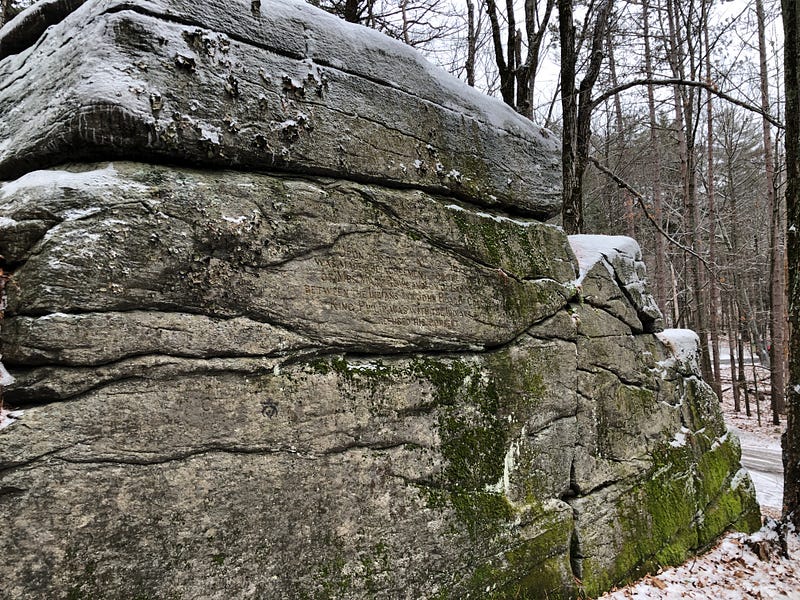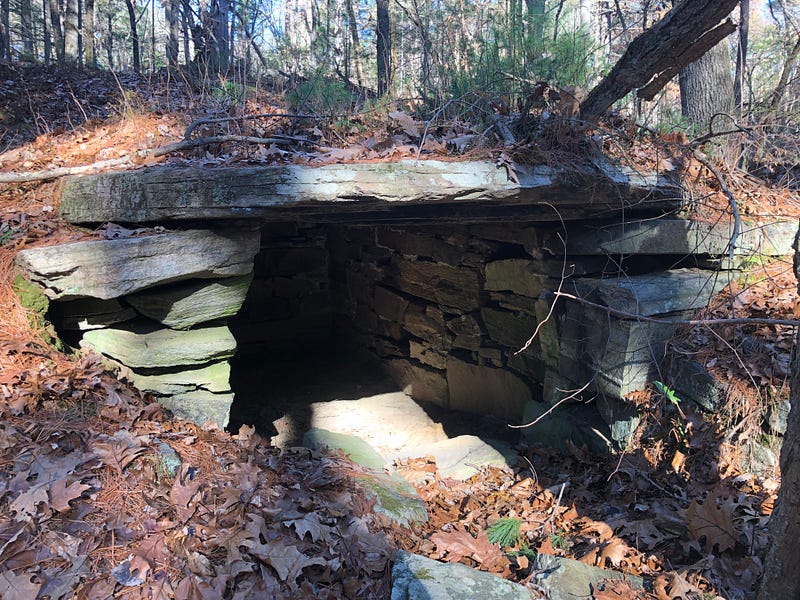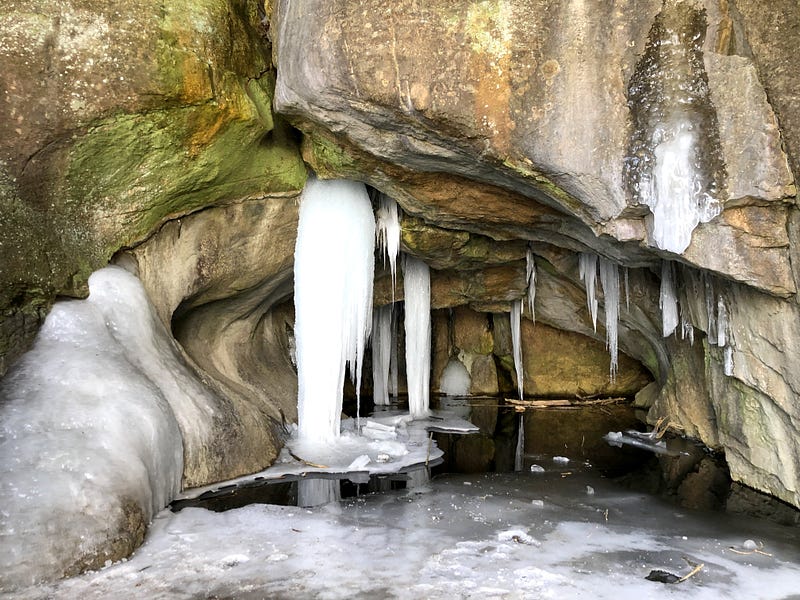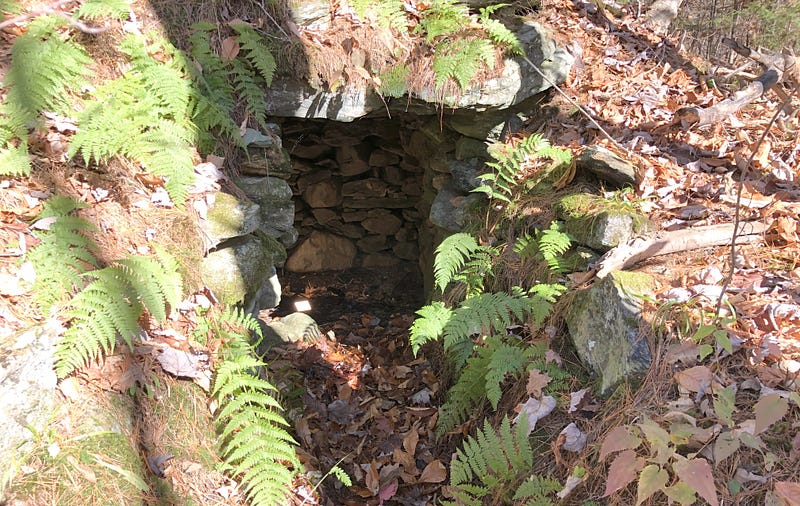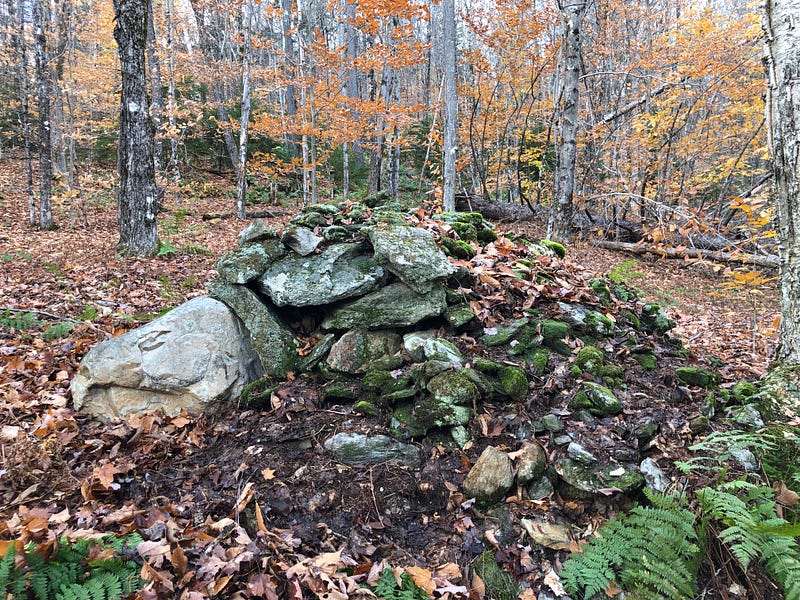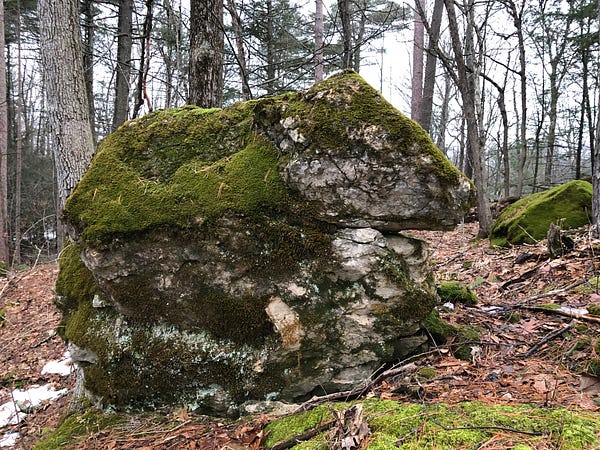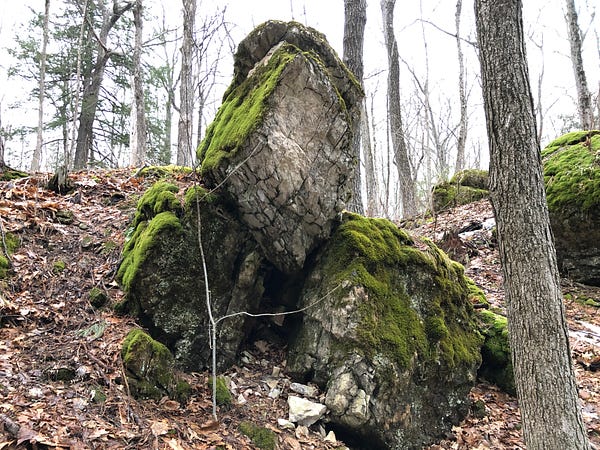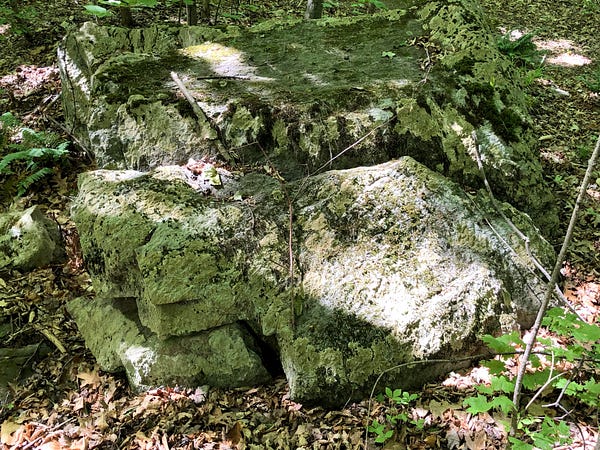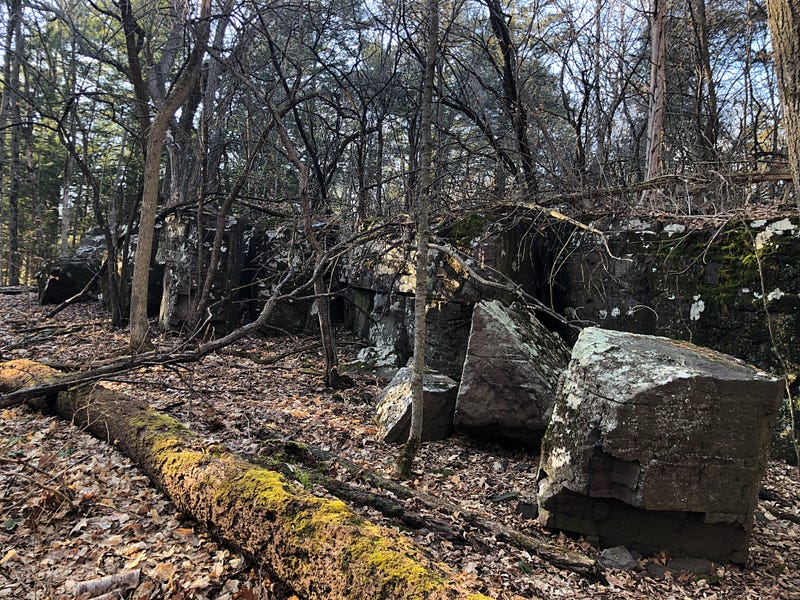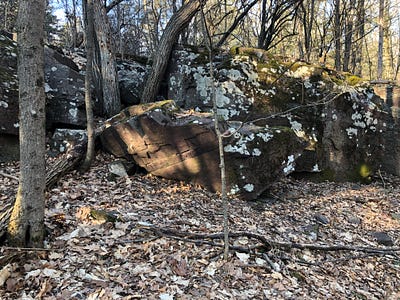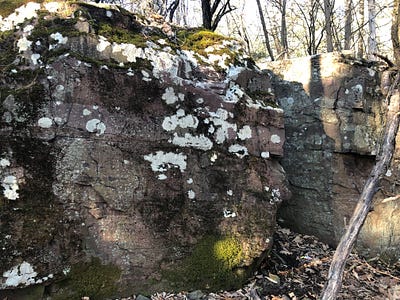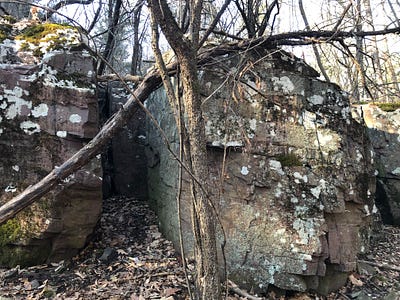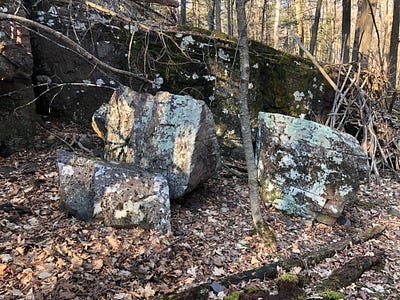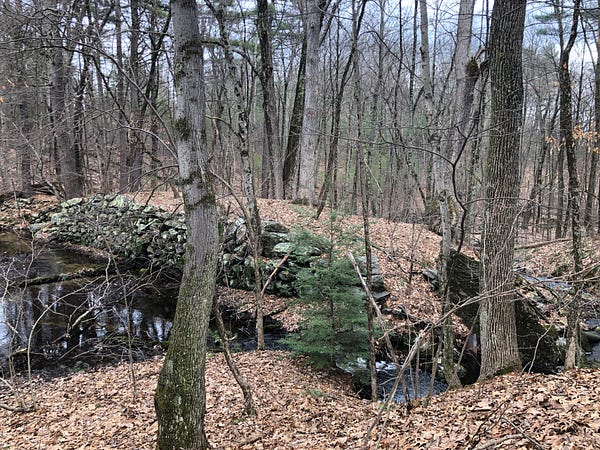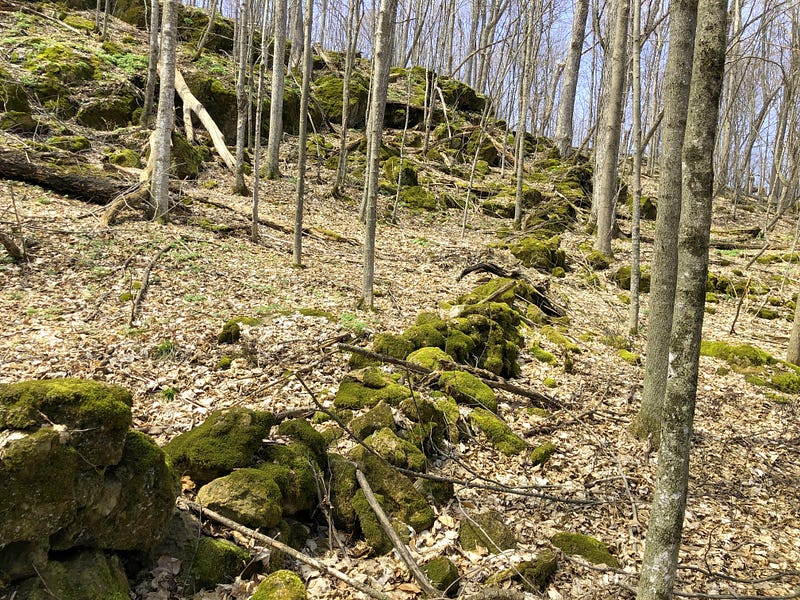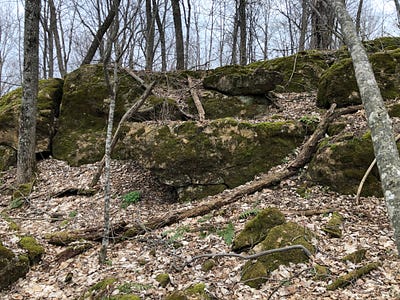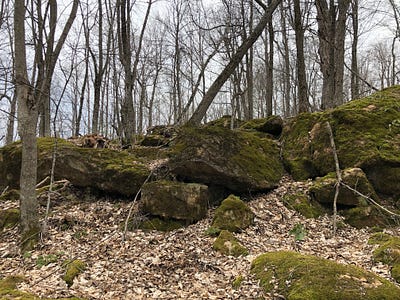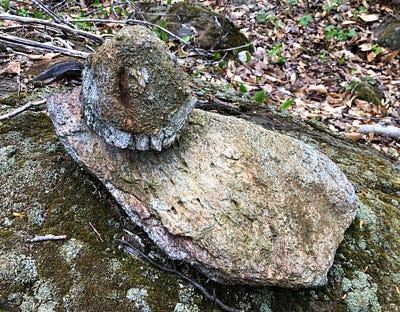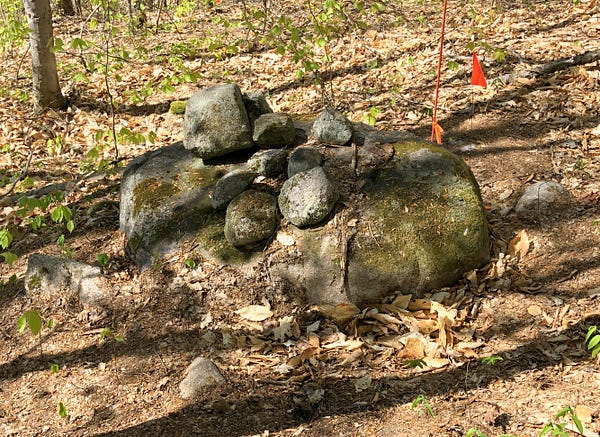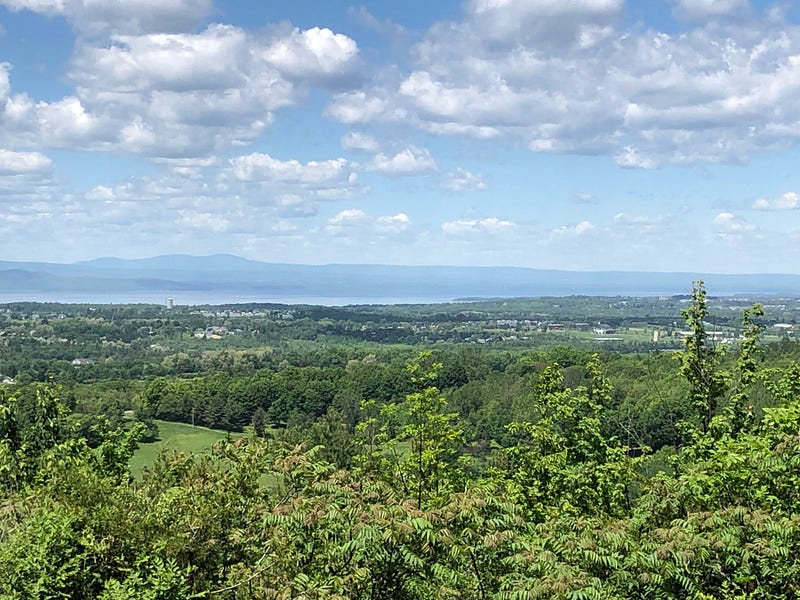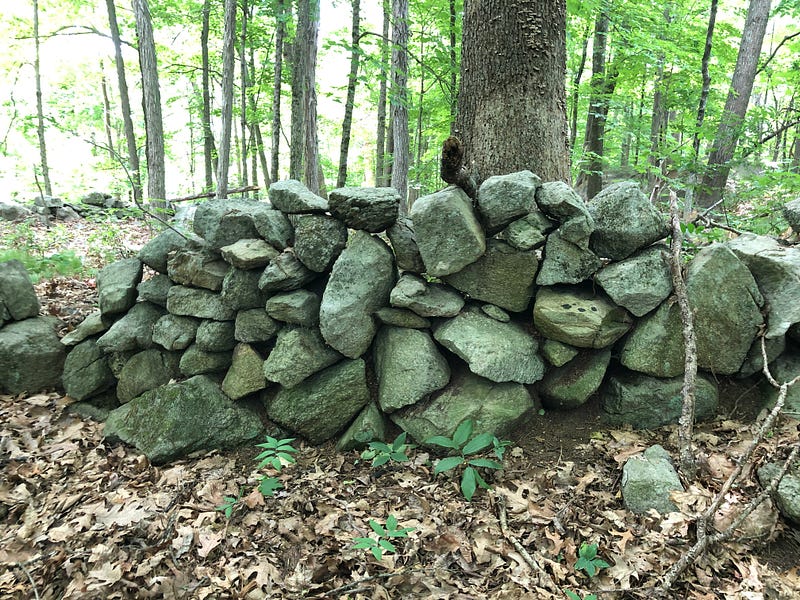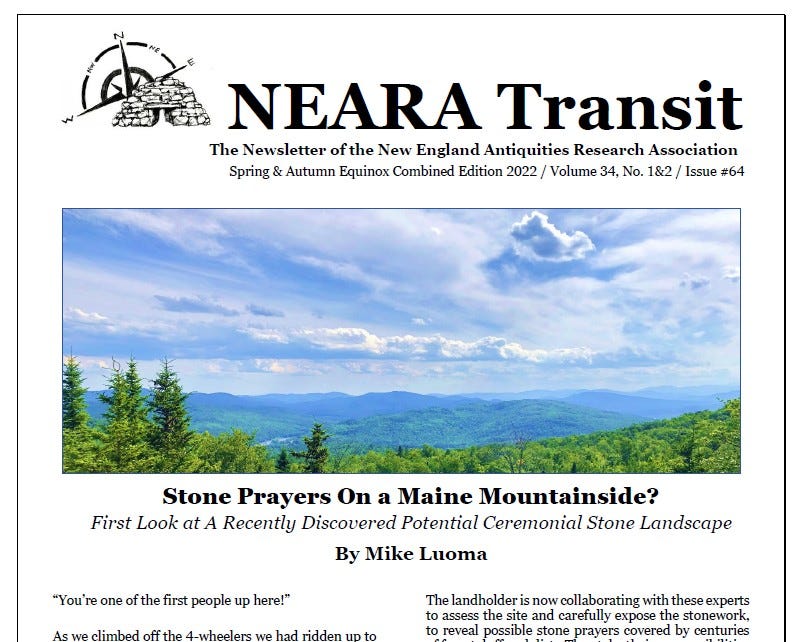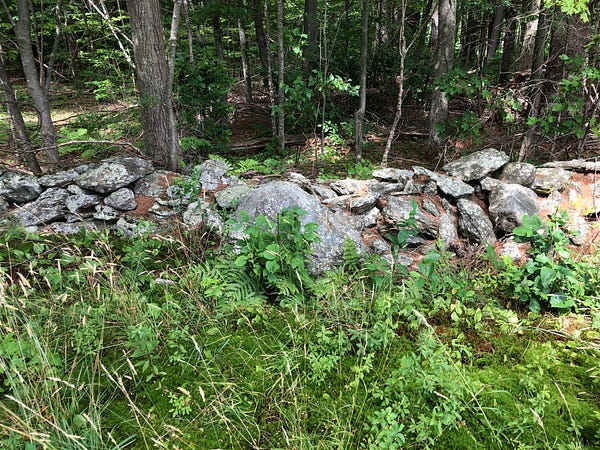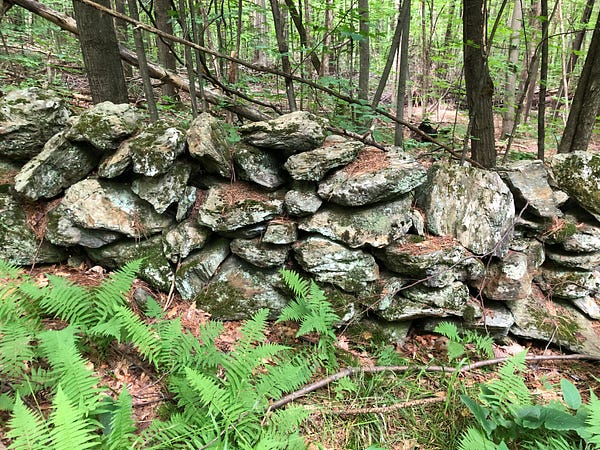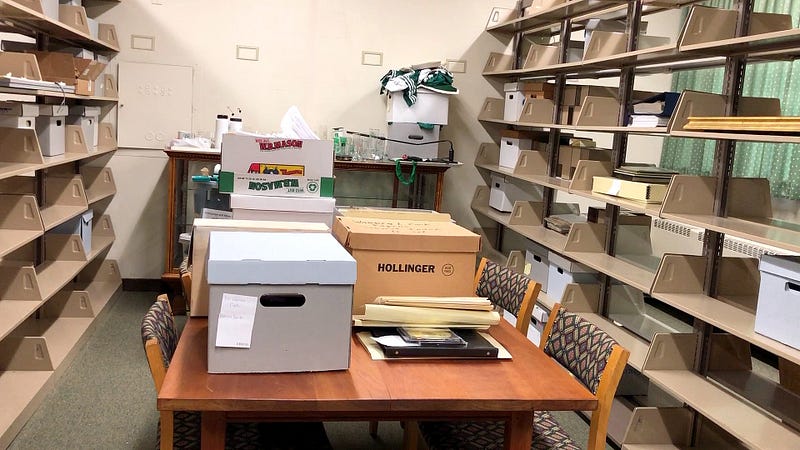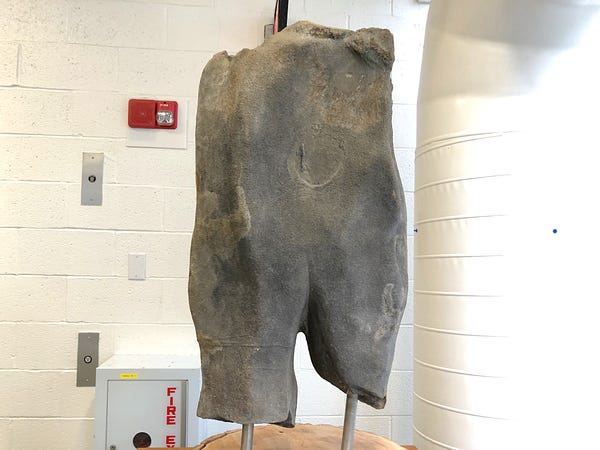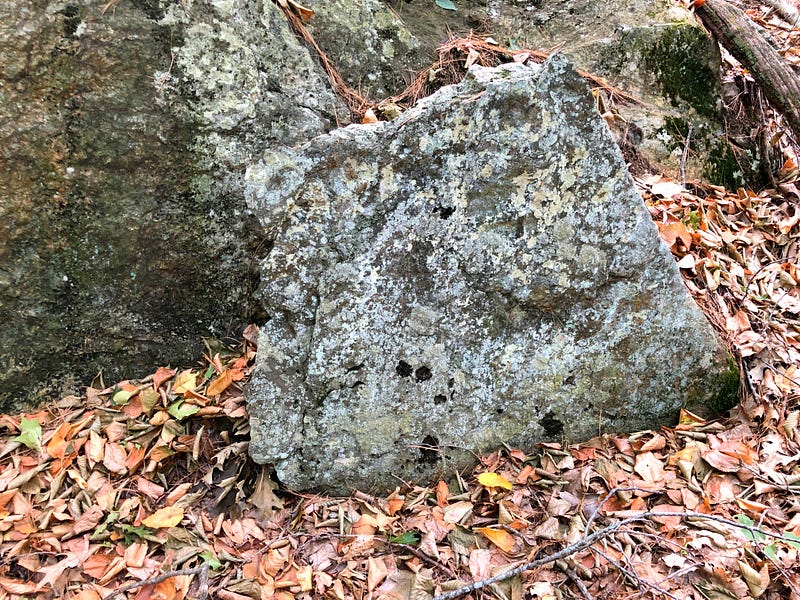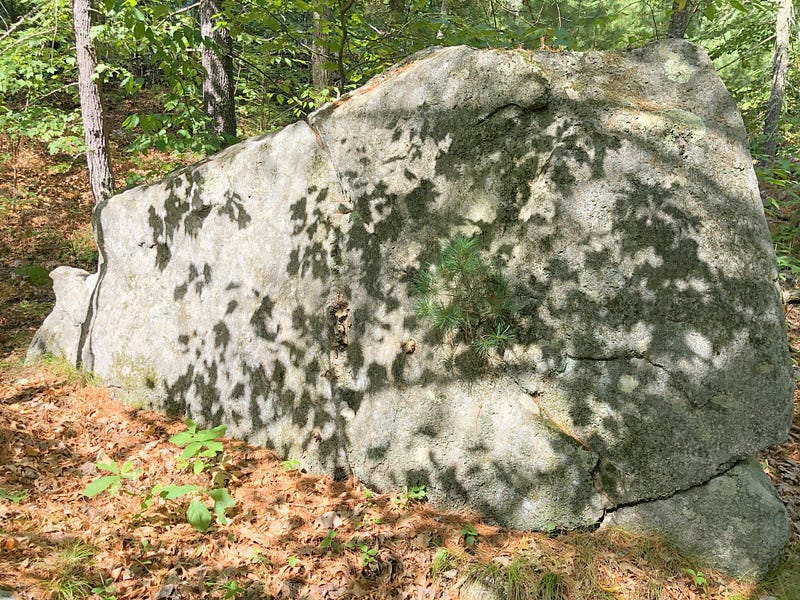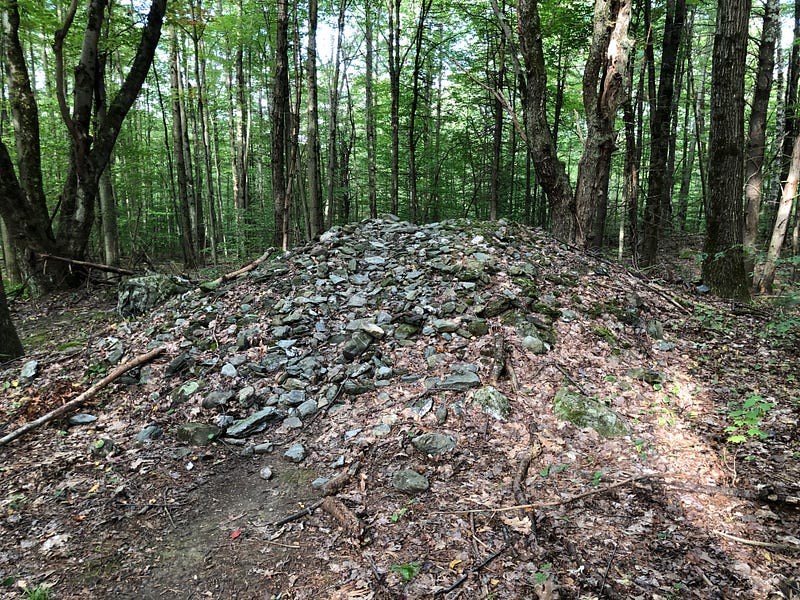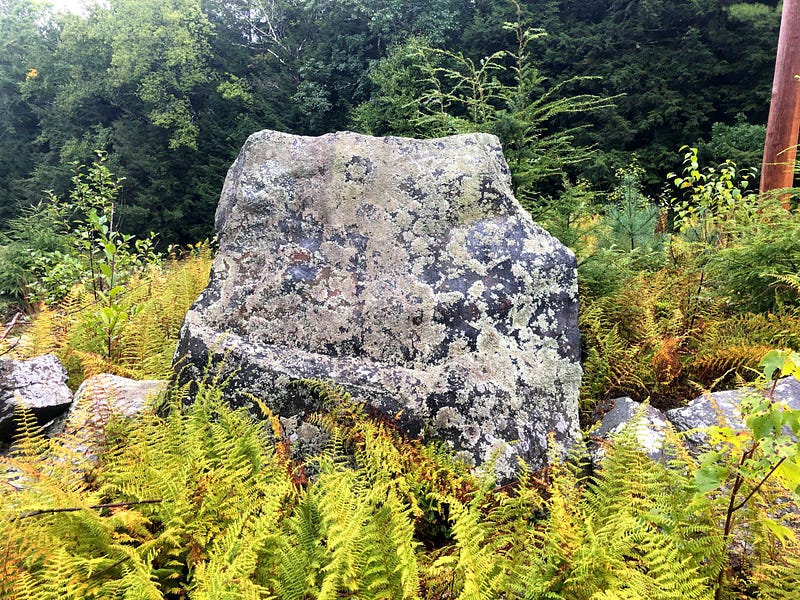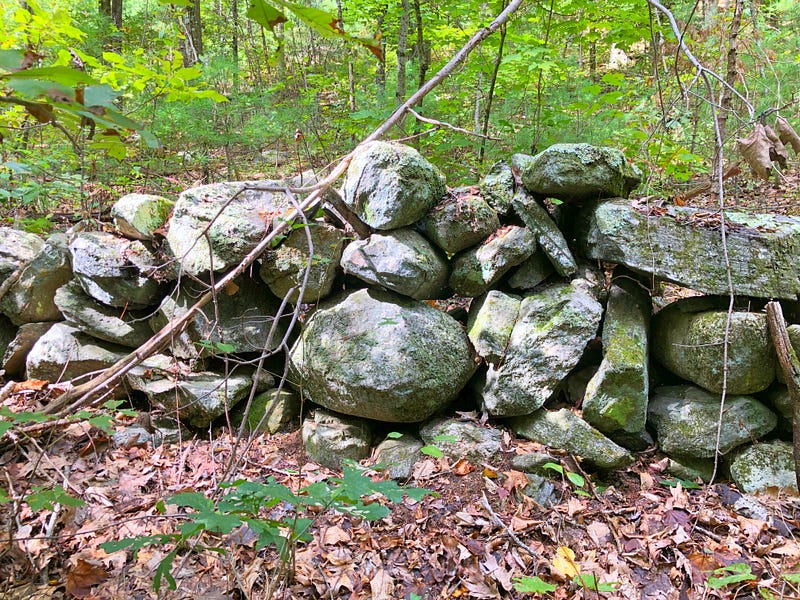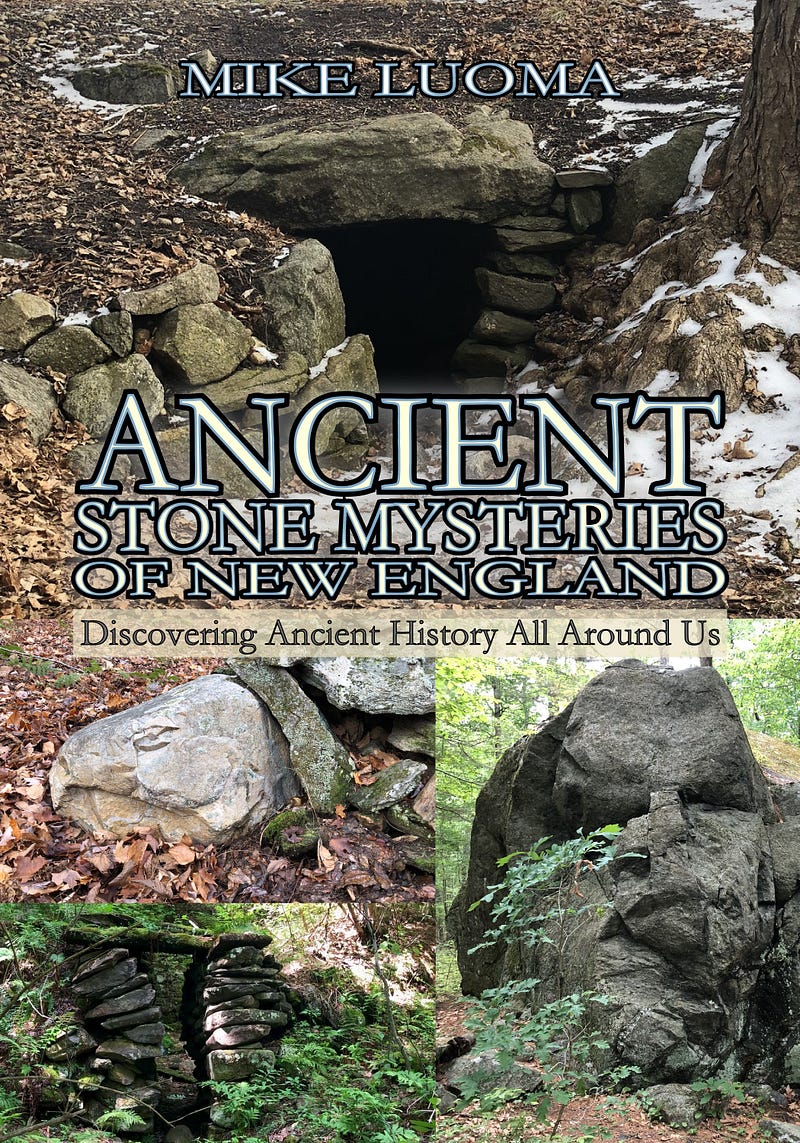My 2022 in Stone Site Investigations
When you’re on the right path, things seem to fall into place, and my journey looking into what remains of possible Indigenous stonework continues to be rewarding.
I’ve just released my new book on investigating the stonework, Ancient Stone Mysteries of New England (details at http://AncientStoneMysteries.com).
My Facebook Group, Ancient Stone Mysteries of New England (https://www.facebook.com/groups/ancientstonemysteries), may crack 12K members before year’s end. And the many different paths I followed this year investigating ancient stone mysteries in the New England woods led to places full of intriguing stonework and other interesting curiosities.
What follows is a chronicle of this year’s explorations, with links to articles and videos for deeper dives where so desired…
January
As the year began, Vermont’s stonework slept under a blanket of snow. With little to see outdoors, I went through videos and photographs from the last six months which had piled up as the result of a midsummer 2021 road trip. I’d also recently visited Gates Pond in Berlin and Redemption Rock in Princeton while in Massachusetts over the Thanksgiving and Christmas holidays. There was plenty to sort through.
I’d discovered Gates Pond had once been known as Kequasagansett…
Rediscovering Kequasagansett
Possible Sacred Stone and Water Works Around Gates Pond in Berlin, Massachusettsglowinthedarkradio.medium.com
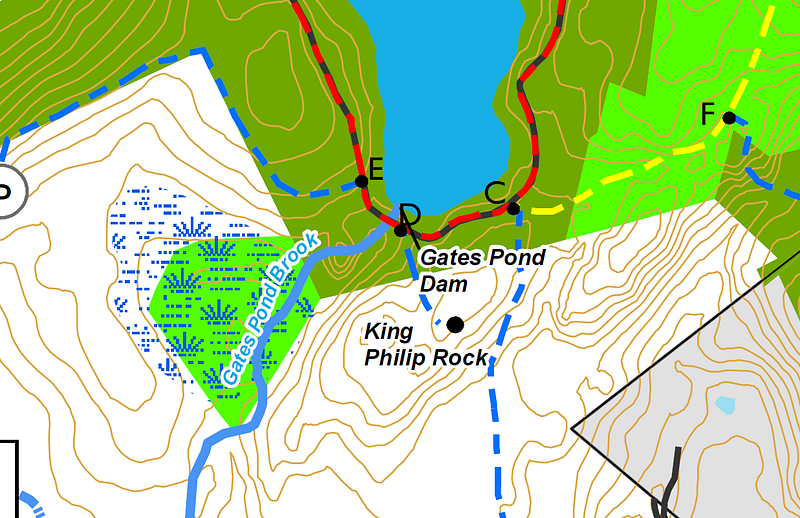
And there on the trail map for Gates, I’d found there was a King Philip Rock. I’d just been given historian Lisa Brooks’ Our Beloved Kin… as a gift, and been wrapped up in reading it. The book is a re-evaluation of King Philip’s War, the first Indigenous attempt to stop the invasion of their lands by Europeans. The coincidence led me to return to find this King Philip Rock. And I shared the story on Medium on January 12th:
Rock of King
Glacial Erratic? Perched Boulder? Shaped Stone? Searching Out King Philip Rock in Berlin, Massachusettsglowinthedarkradio.medium.com
On January 20th, I released my King Philip Rock video, Experiencing King Philip Rock in Berlin, Massachusetts: https://youtu.be/Op8T2gSAQbo.
I’d actually released the video for my visit to Redemption Rock — and a nearby Stone Chamber — two days earlier, Experiencing Redemption Rock and A Stone Chamber in Princeton, Massachusetts: https://youtu.be/OYHt-B03vzA.
But the full write-up on the Redemption Rock visit wouldn’t appear on Medium until a week later, January 26th, as it incorporated a lot of historical research I’d been doing on King Philip’s War:
Blood, Ice and Stone
“Redemption Rock” — A Reminder of Forgotten Historyglowinthedarkradio.medium.com
Earlier, on the 14th, I’d posted my video presentation on a Central Massachusetts Stone Chamber visit back over Thanksgiving, Experiencing a Stone Chamber and Surroundings in Central Massachusetts: https://youtu.be/kM9WzYd9iVM.
The snow was letting me catch up on making some of my video presentations, though I still had at least three more I wanted to put together. And, as February came on, so did a stretch of freezing weather that had me hopeful I might be able to walk into the Donahue Sea Caves in the Burlington, Vermont Intervale, only accessible when the long pond in front of it ices over.
February
February began with the release of two videos, one from me, and one from Matt Adams of NEHSSIE — North East’s Historical Stone Sites Investigations & Explorations — covering a day we’d spent investigating in Central Vermont, when we’d teamed up back in early November.
Our #StoneSiteTeamUpVT1 videos covered two different parts of the day’s investigations. Matt’s video covered our visit to an old Stone Chamber on private property, Stone Chamber Investigation — Central Vermont: https://youtu.be/vghtQwUxmBM. And mine covered our visit to a mountainside of cairn-like Stone Prayers, including one which appeared to be a turtle effigy, Experiencing A Turtle Effigy & More Possible Manitou Hassanash — Central Vermont: https://youtu.be/u7Awe6oEeo8.
I did make it down to the Donahue Sea Caves in Burlington, Vermont’s Intervale right on the first, but the floor of the cavern hadn’t frozen over, despite the winter cold. There may be petroglyphs in the back of the cavern, at least, I think what I’ve seen in the past could be petroglyphs or work of some kind, but I wouldn’t be able to check them out this year. Created a short video presentation on the visit, Back Into The Devil’s Den in Burlington, Vermont: https://youtu.be/6r7W0bre5dg.
Substack began beta-testing video posts, and I used the opportunity to begin sharing uncut, raw video footage from my explorations with a clip from Gates Pond, shared as Rediscovering Kequasagansett — Uncut Video: https://mikeluoma.substack.com/p/rediscovering-kequasagansett-uncut.
Followed up with some unused footage of mine from the earlier Team-Up as Previously Unseen Video — A Central Vermont Stone Chamber: https://mikeluoma.substack.com/p/previously-unseen-video-a-central.
And I began catching up on videos I’d been hoping to put together since summer visits to locations around Burlington, which I’d back-burnered to make my 2021 Road Trip videos (Road Trip videos: https://youtube.com/playlist?list=PLnMOo7Fqttr_RZj3im7nkRuAvlDLeOISq). The first of the Vermont summer catch-up videos was Experiencing The Maple Shade & Misty Meadows Trails in Westford, Vermont: https://youtu.be/HwtiliipTzg.
Also early in the month, Dan Everett from Maine found my Ancient Stone Mysteries of New England Facebook Group and got in touch with me about some stone piles he’d been finding at his place near Rumford. He hoped I might be interested in taking a look at his property. But he didn’t have any photos… and the site was covered in snow.
I wasn’t sure what to think. But Dan seemed sincere and normal. Well, as normal as any of us! We looked at some available LIDAR and maps. I asked where the “stone piles” were and he described the area. It was in a somewhat remote location, but there was a possibility he’d found something. I told him it could be a Ceremonial Stone Landscape, but there was no way to know, yet. We agreed we’d talk more once the snow melted. There was no way yet to know that this would turn out to be a potentially significant site.
This busy week of February was capped off with a piece here on Medium on my return to the Donahue Sea Caves.
Revisiting Land-Locked Sea Caves
A Return to The Donahue Sea Caves in Burlington, Vermont’s Intervaleglowinthedarkradio.medium.com
Substack was proving to be a useful outlet for some of my investigatory work, as I shared more raw footage, some of which hadn’t made the final cut, in a Previously Unseen Look At Redemption Rock: https://mikeluoma.substack.com/p/previously-unseen-look-at-redemption.
Another summer catch-up video came out on the 20th, Experiencing Possible Ancient Stone Work at Colchester Pond in Vermont: https://youtu.be/-hhFGfCgSvU, with an accompanying post at Substack, Do You See What I See?: https://mikeluoma.substack.com/p/do-you-see-what-i-see.
March
In early March, I returned to an area of possible discoveries, stonework around what had been called Arms Forest in Burlington, Vermont. But I’d discover checking online that the city was now calling it Arms Park. It also appeared to now be smaller on city maps. What I’d thought had been a previously open part of the Forest was now marked as off-limits private property belonging to the Burlington Elks Club.
When I’d visited the year before, I’d found two young mountain bikers with shovels cutting what they’d called a step-down into the side of ridge in the forest, near the Elks’ property, and I wondered if general abuse by mountain bikers had closed off the Elk’s ridge to the public. It’s too bad, as the Elk’s ridge features interesting stonework. The surrounding area does as well.
I’d wanted to get a better look at a stone I’d thought could have been an effigy, possibly a Mammoth, as the remains of those have been found in Vermont. When I did, I discovered the possible effigy boulder was actually set between two other stones, in what seemed to be a ramp up onto a ridge, something I didn’t pick up on in last year’s snow. It appears this effigy stone is actually perched between two other stones, between and atop the other two. This seems deliberate. Other possibly worked stones line this entryway to the upper ridge.
I posted video and photos of the possible effigy to Substack, as A Possible Perched Effigy Stone in Burlington, Vermont: https://mikeluoma.substack.com/p/a-possible-perched-effigy-stone-in.
I also re-visited the old quarry on the edge of Arms Park, whose construction I believe may have been a deliberate desecration of an ancient Indigenous Stone Site by a nineteenth-century clergyman. Substack was where I shared Atop The Old Quarry: https://mikeluoma.substack.com/p/atop-the-old-quarry.
The last of my summer catch-up videos came out on March 9th, Experiencing Traces of Possible Stonework at The Milton Town Forest and Milton Pond in Vermont: https://youtu.be/6BNldYCRRzg. I didn’t find much stonework in the forest around the pond, instead seeing signs this area had undergone pretty heavy agricultural usage. Most of what could be possible stonework is fragmentary, shattered and scattered — and thus highly speculative. There are several items of interest and, at the very least, some very curiously shaped stones.
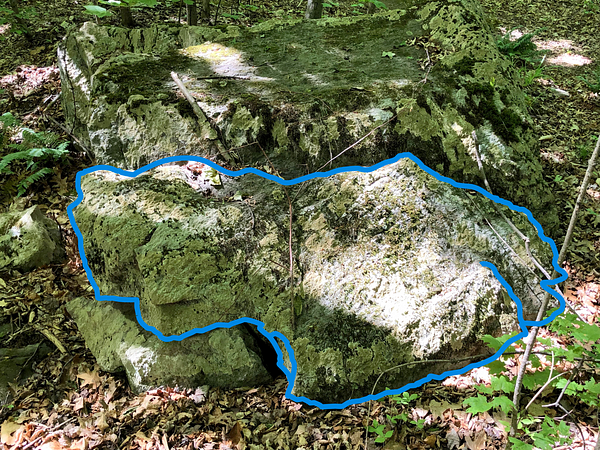
More folks were getting in touch with me about possible stonework they’d found. Matt from Berlin, Massachusetts reached out. He lived just south of Gates Pond and had seen my video and pieces on Rediscovering Kequasagansett, and invited me to his property so he could show me an old mill dam in the woods next to his house. We se up a visit later in the month.
Melanie from Waterville, Vermont contacted me about stonework in general and said her family had some interesting stones on their land, though they were still covered in snow. She also asked if I’d been to the cave in Red Rocks Park in South Burlington, on the shores on Lake Champlain. I had not. She said she knew where it was and offered to show me to it, so we met up at Red Rocks Park soon after. But she couldn’t find the cave.
We climbed cliffs and walked some precarious ledges, but she couldn’t locate it based on her memories. A bit disappointing. We wandered the Park after, and I found you could see Odzihozo from Red Rocks Park, a prominent stone in the lake, at the entrance to Shelburne Bay — somewhat of a consolation.
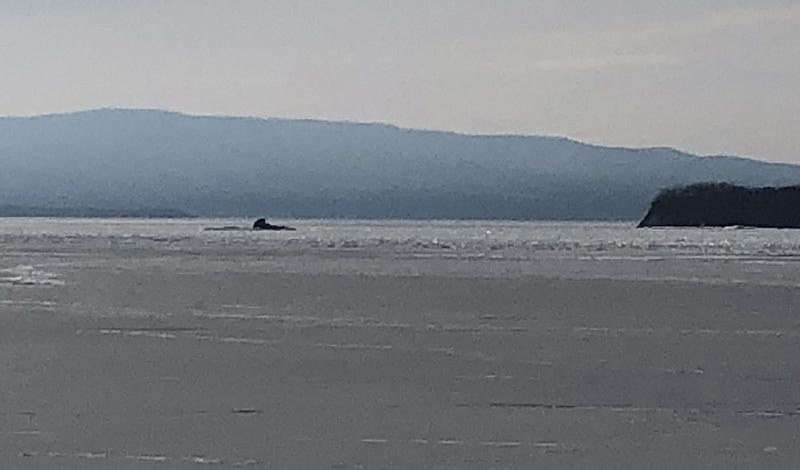
This rock off Shelburne Point on Lake Champlain has been known by the Abenaki as Odzihozo, the Transformer, since time immemorial. I didn’t realize I’d be able to see Odzihozo from there, so it was a pleasant surprise.
On a meta-level, the fact a Giant Boulder in this Lake is associated by this area’s Indigenous People with a Spirit Being — for this is said to BE Odzihozo, not just represent him — seems to provide some contextual proof for the existence of Sacred Stones among the ancestors of the Indigenous folks in this area.
There were giant boulders in the park as well. Two huge boulders sat side-by-side near the lake shore. The upright one seemed to have the suggestion of a face in profile. The other one looked like a boat, or a table.

These didn’t appear to be glacial erractics, technically, as they seemed to be composed of the local Dunham Dolostone. They may not have been moved that far by the ice.
I shared some footage and photos in my Facebook Group, and on Substack — Facial Erratic? — Exclusive Raw Video of a Walk-Around of a Pair of Boulders in Red Rocks Park on Lake Champlain: https://open.substack.com/pub/mikeluoma/p/facial-erratic.
Another low ridge near the boulders caught my eye, but what seemed to be a class of schoolkids or daycare charges were clambering atop and around them while we were nearby, so I didn’t get a good look at it. Still, something about its appearance clicked, and stayed with me after my visit — it looked like stonework that I believe I’ve been finding which is much bigger than expected, which I’ve dubbed Possible Large-Scale Great Serpent Stonework.
I returned on my own a week later to get a closer look at that ridge.
As for my theory, I think we’re seeing in some cases and some places landscape-sized work, ridges and ledges turned into Large-Scale Serpent Effigies through the deliberate addition and placement of shaped boulders and other stones.
The added stones’ edges are often apparently worked to help the rocks resemble the gills, feathered fins and wings, and other features of the Great Horned and Feathered Serpents found in ancient Indigenous traditions.
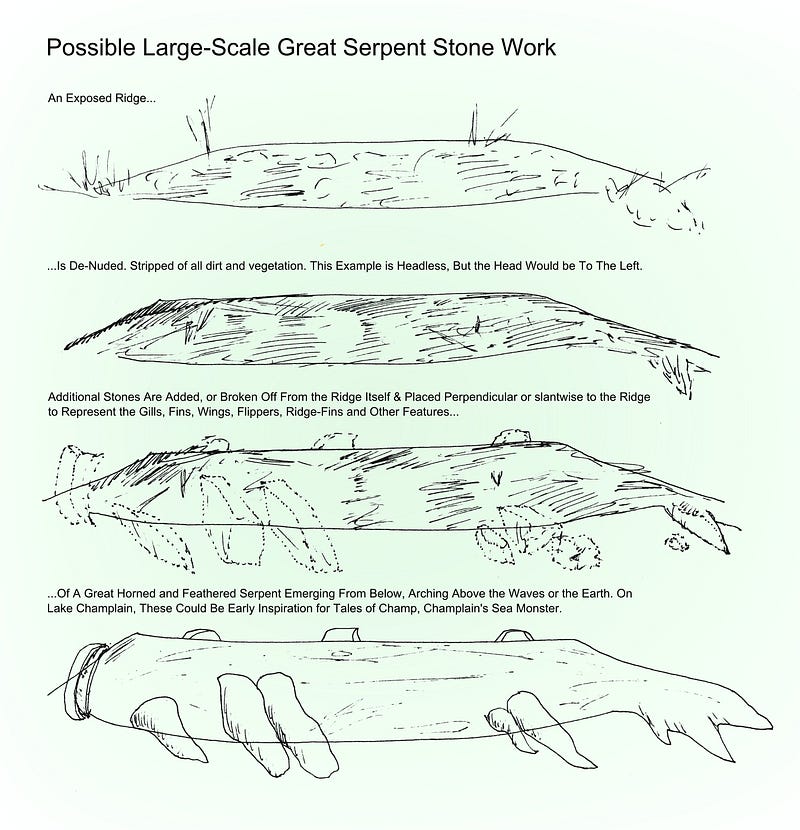
These two illustrations help explain what this looks like. The illustration on the left gives a general theory on how this stonework might have been accomplished. My illustration on the right features a small ridge like the one in Red Rocks Park. Added stones are drawn as dotted lines in the third image down, and fins in the final image.
This stone work is done at various scales. I’ve found it alongside small ledges and large mountain ridges. The themes and means of portraying the iconography are repeated at whatever scale the landscape suggests, even employing enormous boulders on some small mountain ridge sides.
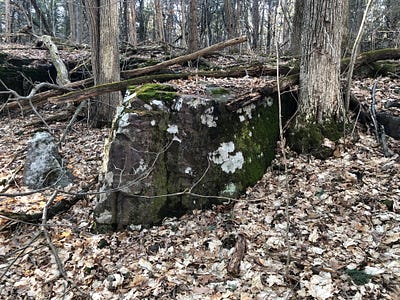
The altitudes at which I’ve found this work at sites around Lake Champlain suggest it could have been done in the Champlain Valley at sea level around the end of the Ice Age when a much larger Champlain Sea covered this part of the world. Perhaps by an ancient, Indigenous, sea-going culture, as the work seems oriented towards bodies of water.
This is still a speculative theory, of course. For now. But this low ridge in Red Rocks Park provided a great example of the sort of stonework I’m describing. I began work on a video based on my visits, but thanks to the illustrations and scripting — and a visit to a couple of Massachusetts sites — it wouldn’t premiere until late April, Experiencing Possible Serpent Work, Odzihozo and More in Red Rocks Park in South Burlington: https://youtu.be/jUQEkT10ifs.
That weekend, I made my way down to Massachusetts and checked out the Old Stone Mill Dam on Matt’s land in Berlin. I’d thought this could be a mill where an abduction had taken place in the early 1700’s, but a local historian corrected me, and said this mill dam had likely been built in the 1780's.

Impressive stonework, now sitting unused in the Berlin woods. Remarkable how huge the stones were — this was some monumental stonework! There didn’t seem to be indigenous stonework in the dam, but stone rows flowed downhill into the waters below the dam. These stone rows look to be indigenous in origin, but rebuilt and added to over time, as the lower stones appear older. The stone row on the right, when looking south from the dam, terminated on the hill with what looked like a tail fin stone.
I shared a little Raw Footage on Substack — Raw Video: An Old Stone Mill Dam in Berlin, Massachusetts: https://mikeluoma.substack.com/p/raw-video-an-old-stone-mill-dam-in. The YouTube presentation, Experiencing An Old Mill Dam in Berlin, Massachusetts, was about six minutes long: https://youtu.be/77FHTt22JmU.
While in Massachusetts, I paid a visit to a site in Hudson I’d been wanting to check out, Danforth Falls, an impressive set of waterfalls and rapids on the Danforth Brook as it gurgles towards downtown on its way to the Assabet River. I shared video of the falls soon after as Experiencing Danforth Falls in Hudson, Massachusetts, which featured the water alone: https://youtu.be/LPSpnNApwHE. A stonework video would follow a little later, Experiencing Possible Effigy Rows & Stones and Danforth Falls in Hudson, Massachusetts: https://youtu.be/_BdM-_dNvZw.

April
Not every site visit yields discoveries. April visits to Vermont’s Shelburne Pond in Shelburne, Wheeler Nature Park in South Burlington and The St. Albans’ Town Forest didn’t yield much in the way of new discoveries, though there were a few curiously shaped stones in Saint Albans. I also visited the “Whales Tails” in South Burlington late in month, and those are made of black granite, but they’re a relatively recent stonework. Of course.
After disappointments at Shelburne Pond and Wheeler the first Saturday of the month, that Sunday I returned to Indian Brook Reservoir Park, in Essex, the first of two visits I’d make there over the next week. The town’s regular season would soon begin, with restrictions on non-residents and admission charges, but the park was still open to all as I ventured there twice early in the month.
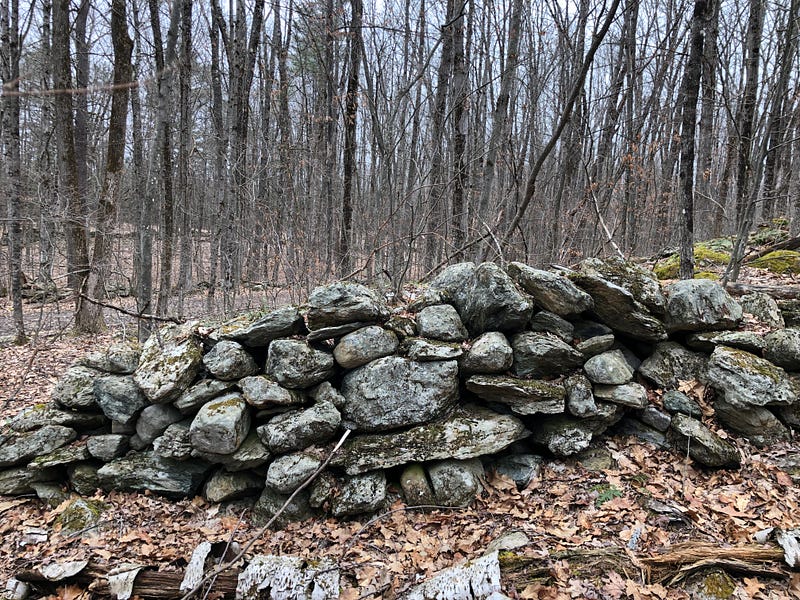
The first day in the park, an overcast sky brought out the best of the stonework on my photos and in my videos, and I found myself focusing on long stone row walk-alongs of what I consider to be possible Indigenous Serpent Row stonework. Wrapped up in walk-alongs and new discoveries they were yielding, I didn’t even manage to reach the Boulder-Head Serpent Effigy Row to the north of the reservoir that had sort of been my goal — oncoming rain and dusk brought an end to my day before I reached it.
I shared several of the stone row walk-alongs in my Facebook Group that evening, along with posts on some of the other stone and boulder forms I’d found, but I still wanted to revisit the possible Boulder Head Serpent Effigy.
Three days later, I returned and headed almost directly up to the Boulder Row. The brisk and sunny Spring day wasn’t as conducive to photos and videos of the stonework, but the Boulder and its stone row were shaded, somewhat, by the interlaced branches of the bare trees overhead, and I was able to explore more of the possible Boulder Head Serpent Effigy stone row and check out its surroundings a bit more thoroughly.

There was so much video from these two afternoons that the YouTube presentation, featuring the long stone row walk-alongs, was almost two hours in length, Possible Serpent Effigy Rows & Manitou Hassanash — Returning to Indian Brook Reservoir in Essex, Vermont: https://youtu.be/GEra-lpC6yk. And there was still enough left over for me to share a boulder walk-around which hadn’t made the final cut as an extra over on Substack, Around A Lakeside Boulder at Indian Brook Reservoir (Bonus Footage): https://mikeluoma.substack.com/p/around-a-lakeside-boulder-at-indian.
On my next trip down to Massachusetts I met up with another stone site enthusiast I’d met. After we visited the Central Massachusetts Stone Chamber I’d released video on in January, Amanda suggested checking out an area near Berlin, Massachusetts’ Forty Caves. We saw several glacial erratics and some other evidently natural forms. Interesting, but not necessarily indicative of Indigenous work. But later she texted she’d found something more interesting driving near where we’d walked, and asked if I’d be interested in seeing it.
The next morning, she led us to a possible Perched Boulder sitting atop a possibly augmented bedrock outcrop, as seen in the opening photo to this piece. A likely Serpent Effigy Row rose up out of a vernal pool not far from the boulder. Other nearby stone rows were also serpentine, snaking along streams and brooks down the trail, downhill from the perched boulder. Several groups of boulders held curious shapes. Yes, this was much more interesting.
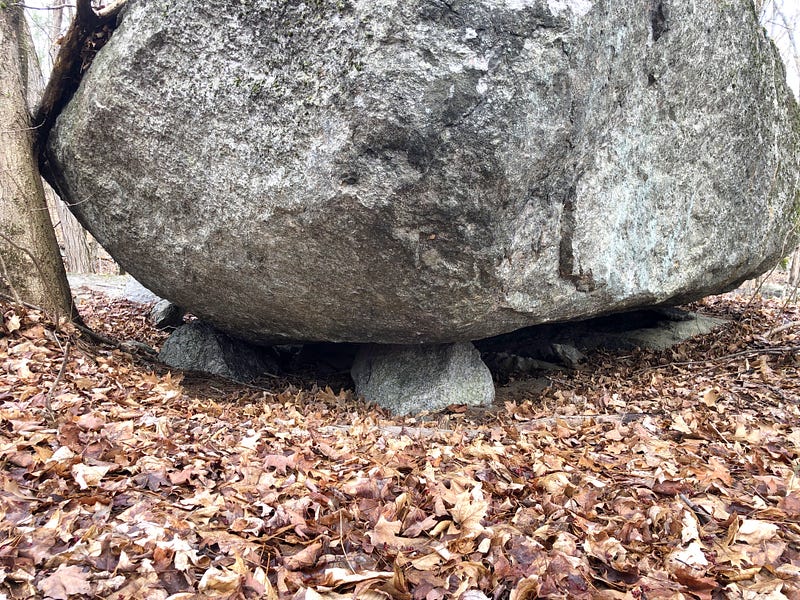
I first shared the discoveries on Substack as Raw Video of A Perched Boulder — Sharing A Discovery from This Past Weekend and Some Musings on Geology: https://mikeluoma.substack.com/p/raw-video-of-a-perched-boulder. It took me couple more weeks to put together the finished video presentation, Experiencing A Perched Boulder and Possible Serpent Row in Berlin, Massachusetts: https://youtu.be/SxMr259aWgk.
On the last full weekend of the month, I headed up to Saint Albans on the Saturday, but was mostly disappointed with what I saw, after a scouting trip the previous winter had made me think I might find more. Still, there were a few interesting stone features to share in my Facebook Group.
I decided to return to Eagle Mountain in Milton, Vermont that Sunday, one of my favorite Chittenden County, Vermont sites which I’ve covered extensively in the past. As I approached the summit from the south east, I noticed a stone row to the north which I hadn’t seen before. I made my way over to it and followed it as it ran up the side of Eagle Mountain. This appeared to be an ancient stone effigy row.
Coming up and over the summit’s northern side, I made my way down to a curiously squared-off ledge which seemed to be embellished and augmented with added stone to resemble a giant wing sweeping off of the summit.
Again, I shared these findings in several posts in the Facebook Group. I didn’t end up putting a new video presentation together. At least, not yet.
April also saw Dan from Maine get back in touch about the possible Stone Prayers he’d found on his land on a mountainside near the town of Rumford. As he began sending photos of what he was finding, I started making plans to go visit the site in mid-May. Based on photos and videos he’d started sending as the snow melted, it certainly appeared as if Dan had found a Ceremonial Stone Landscape on his mountain.
May
As May began, I was making plans to head East mid-month, across New Hampshire past Mount Washington over to Rumford in Western Maine to check out possible stone prayers landholder Dan Everett was discovering on his mountainside property. Dan sent me increasingly interesting photos and videos as the snow cleared off the mountain. It was going to be something to see this site for myself.
At the month’s outset, however, I set out for Williston, Vermont for more explorations around Lake Champlain. Five Tree Hill Country Park featured a trail up to the Overlook, a high spot looking out over the Champlain Valley, the lake, and the Adirondacks beyond, roughly seven miles inland.
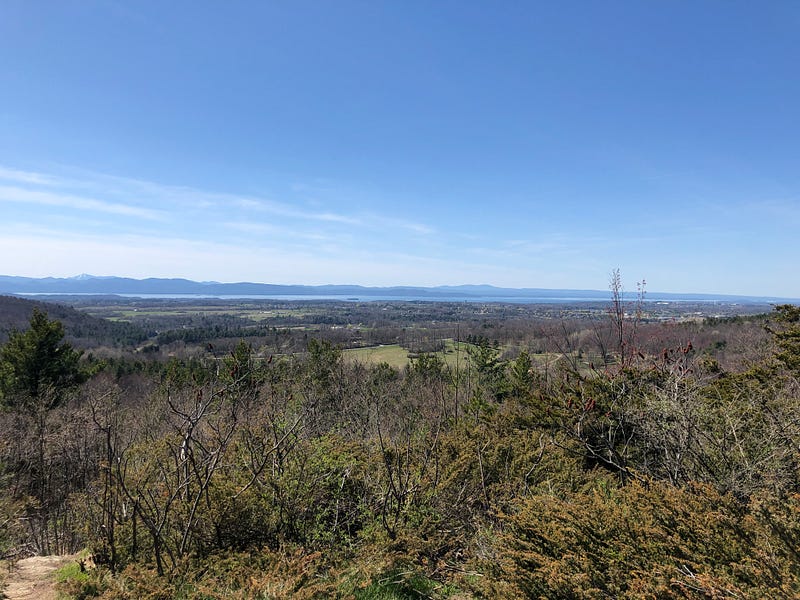
This is about the same distance from the lake as Indian Brook Reservoir Park and Colchester Pond to the Northwest, and Raven Ridge to the Southwest. I hadn’t been out this way yet, almost directly east out of Burlington. Archaeological digs between here and Indian Brook Reservoir Park in the 1990’s found Indigenous habitation sites dating back through at least 11,000 years of continuous habitation, back to Paleoindians at the end of the Ice Age living on the shores of the Champlain Sea.
I found possible effigy stone rows on the Five Tree Hill side east of the Overlook, then descended from the Overlook on the other side, down the Sucker Brook Hollow Country Park trail. I’d seen a boulder mentioned on trail maps and thought I’d see if I could find it.
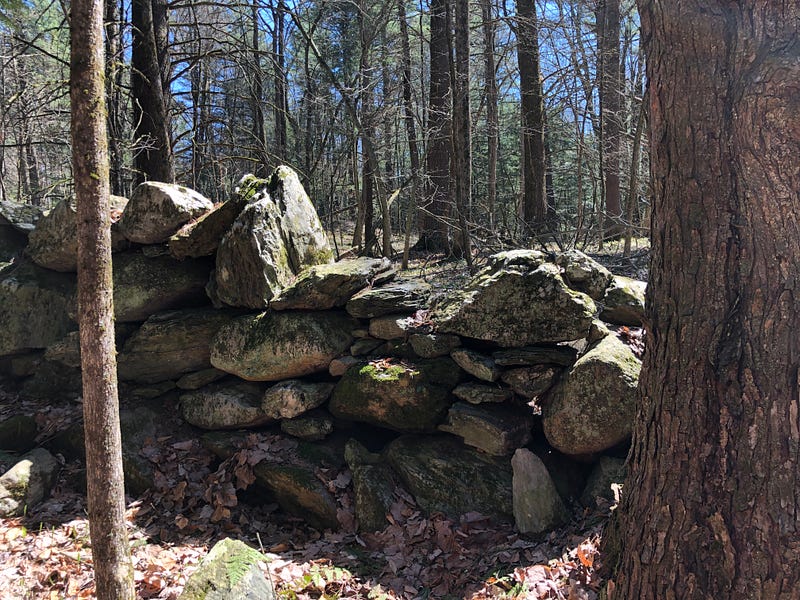
I found another fascinating possible effigy stone row on this side, this one related to water, a spring and a brook. After checking out and shooting photos and video of the stone row, I decided not to keep descending, as I was going to have to retrace my steps and climb back up and over after. I’d be back in about a month to climb up from this side of the Overlook.
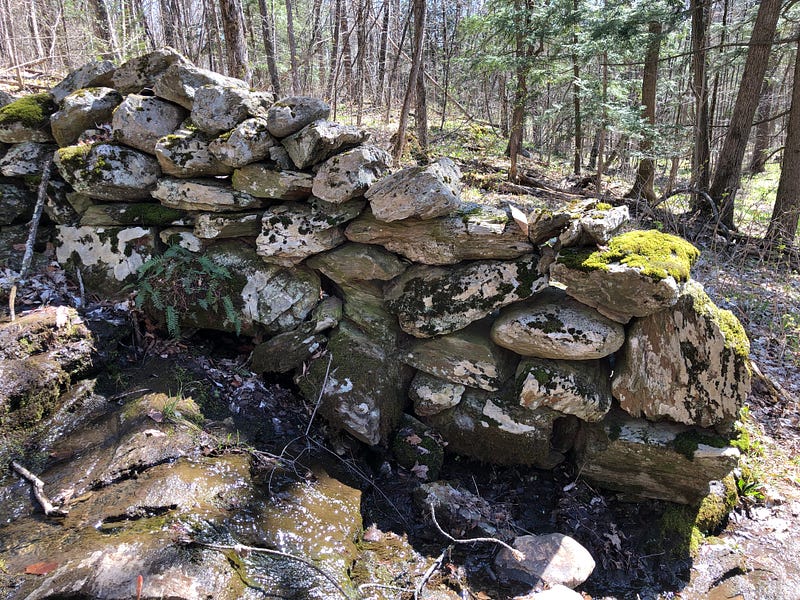
The next two weeks were dedicated to finishing up the Indian Brook Reservoir and Perched Boulder video presentations, and the bonus Substack post, mentioned and linked above, from my site visits in April.
Then, I headed out for Maine to meet Dan Everett in person and see his possible Ceremonial Stone Landscape on his property. We spent the weekend checking out the possible stone prayers found on his mountainside, and I wrote up the visit for a piece here on Medium within the week:
Stone Prayers On A Maine Mountainside
First Look At A Recently Discovered Potential Ceremonial Stone Landscapeglowinthedarkradio.medium.com
Shared a little video footage over on Substack, A Possible Stone Prayer On A Maine Mountainside: https://mikeluoma.substack.com/p/a-possible-stone-prayer-on-a-maine.
I was able to put my 30-minute YouTube video presentation on the visit together in just over a week, Experiencing A Recently Discovered Potential Ceremonial Stone Landscape On A Mountain in Maine: https://youtu.be/MUJfzxbVCjY.
Later in the month, on a mid-week trip to Massachusetts, I met up with fellow Stone Site Investigator Amanda once again, and we made our way to Acton, to their Trail Through Time and the Nashoba Brook Stone Chamber. I enjoyed exploring with Amanda — it wasn’t always easy to walk stone sites with others, yet her approach, her intuition and observations, meshed easily with my own. She spotted several features I missed, as well.
The Trail Through Time features several clusters of Stone Prayers with accompanying kiosks offering descriptions and definitions of Stone Prayers, Indigenous culture in this area, the United South and Eastern Tribes (USET) Declaration that this is part of a Ceremonial Stone Landscape, and other supporting information.
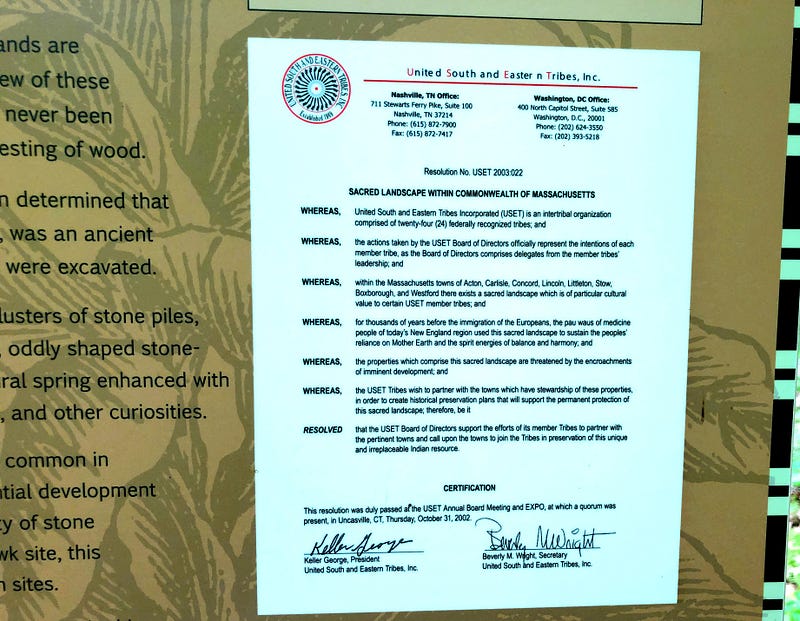
Posted some Raw Footage on Substack a couple of days later, The Nashoba Brook Stone Chamber: https://mikeluoma.substack.com/p/the-nashoba-brook-stone-chamber. And I shared many posts from here and the other sites visited this month in my Facebook Group.
The YouTube video presentation of our visit to the Acton site premiered on the 31st, Returning to The Nashoba Brook Stone Chamber and “Trail Through Time” in Acton Massachusetts: https://youtu.be/0RMp5kKKyDY.
And before the month ended, I paid a third visit to Lone Rock Point on the north end of the Burlington, Vermont waterfront. On the Sunday of Memorial Day weekend I thought I might check out the Champlain Thrust Fault again.
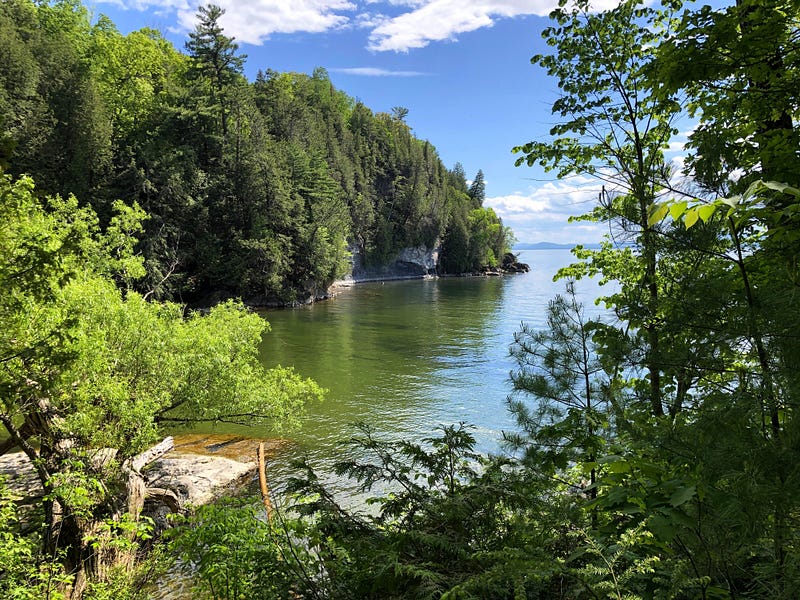
But I found a group of college kids had commandeered the area next to the Fault as their party place that afternoon, swimming and drinking. Not conducive to photography or video of that space. However, before I’d reached it, I’d been able to get a good distant shot of the peninsula and the Fault, and additional photos and footage of other stones of note.
June
As the month of June arrived, a concept, ideas I’d been trying to get in focus, finally began to gel. I’d been wanting to write a book about the stone sites I’d been seeking out. But I’d been cautioned to be careful in publishing anything on the stonework when I released a Calendar featuring sites last September. It was important to me not to exploit or otherwise disrespect the Indigenous Peoples whose work I was trying to identify and highlight. Still, it seemed important to get the word out that this work even existed in the first place.
Ever since I’d first visited the Upton, Massachusetts Stone Chamber in late 2019, I’d felt compelled to find stone sites and let people know they existed, to let people know about Indigenous Ceremonial Stone Landscapes, and that this ancient history is possibly all around us. I‘ve been doing that with the Facebook Group, which at this point was now growing almost logarithmically, with over 9600 members.
My book could be an extension of this, a way to introduce people to these concepts through the story of my own introduction. Using a sort of subjective reportage, creative non-fiction, I began to chronicle my stonework journey. Sharing my own learning process might help others to learn more as well.
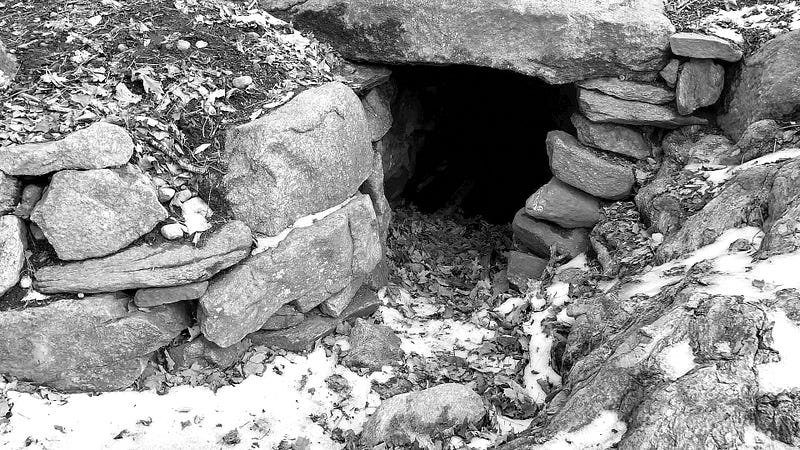
I’ve self-published for years, and decided to put out this one, too. Doing everything myself, I began to both write and lay out the photos as I went along. Each of the color photographs I wanted to use had to be converted to Black and White for the interior of the book, as a full-color book would, unfortunately, be prohibitively expensive.
There were many files and notes I’d been compiling which now needed to be brought together — work on my book was underway. I knew what I wanted it to be, what shape it would take. But I had no idea how long it would take me to write the thing and put it all together, so I decided not to say anything publicly yet, at this point.
The first weekend of June I headed back to The Overlook in Williston, Vermont, this time via the Sucker Brook Hollow Country Park, on the Western side of the ridge with the Overlook, which I’d explored a bit of on my trip through Five Tree Hill Country Park. I wanted to see more of the water-related stone row I’d found on this side a month ago, and hoped to see the boulder highlighted on the hiking map.
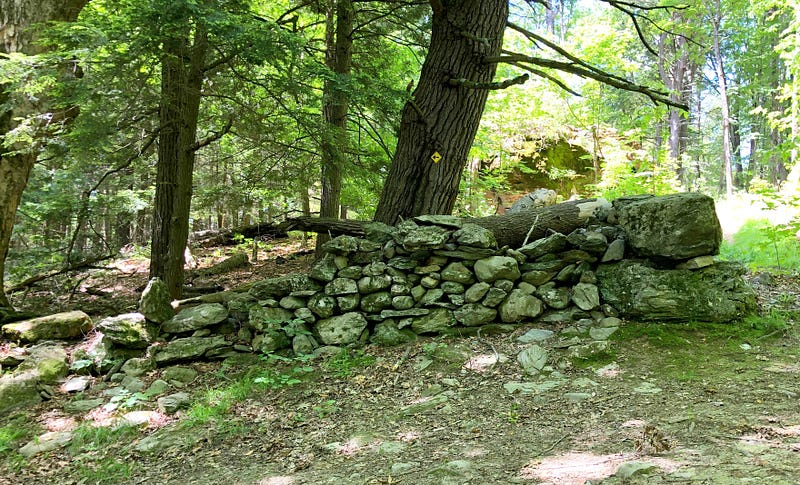
As I climbed up the trail, I found some Wing-Shaped Stones, and then, a bit higher up, a Possible Stone Effigy Row. I followed this stone row until the point two Serpent-like Boulder Heads met and it turned a sharper than ninety-degree corner — and headed for the huge boulder I’d been hoping to find. I revisited the other stone row as well, and the Overlook. Things were now a lot greener up there.
The YouTube video presentation covered both trips to the Overlook, the Five Tree Hill one in early May and this Sucker Brook Hollow visit, Experiencing Possible Serpent Effigy Rows Near the Overlook in Williston, Vermont: https://youtu.be/pln5c_mQNto.
The next weekend found me in Massachusetts, again. Amanda and I set off to explore the Upton, Massachusetts Stone Chamber and nearby Pratt Hill. Our friendship had developed into a great relationship — this was the first time we’d explored together as a couple. I wanted to show Amanda the Upton Stone Chamber because it had meant a lot to me on my stonework journey, and Pratt Hill is an important part of the landscape associated with the chamber. I was interested in her impressions of and observations on both places. Once again, she found stonework I’d missed, and meshed well with my quiet investigational approach.
The video presentation, Returning to The Upton Stone Chamber and Pratt Hill in Upton, Massachusetts, combined both this visit and my first return visit I’d made the past summer: https://youtu.be/ti90j31cc_I.
Back in Vermont the next weekend, I traveled down to Vergennes, Vermont, next to Lake Champlain, to the Lake Champlain Maritime Museum Abenaki Heritage Festival. I thought I might be able to meet more local Abenaki and see if there was any chance to ask anyone about possible ancestral stonework.
I didn’t know if any opportunities would present themselves, and they did not. Dr. Frederick M. Wiseman presented on the health of the Vermont Abenaki — which he was not optimistic about. I learned in his presentation some younger, reservation-based Odenak Abenaki from Canada were denying the heritage of the Vermont Abenaki and calling them “Pretendians” for reclaiming their lost heritage, which included personally attacking him and his work in vicious ways. Somewhat alarmingly, they’d been given an unquestioned soapbox by UVM — the University of Vermont — a few weeks earlier.
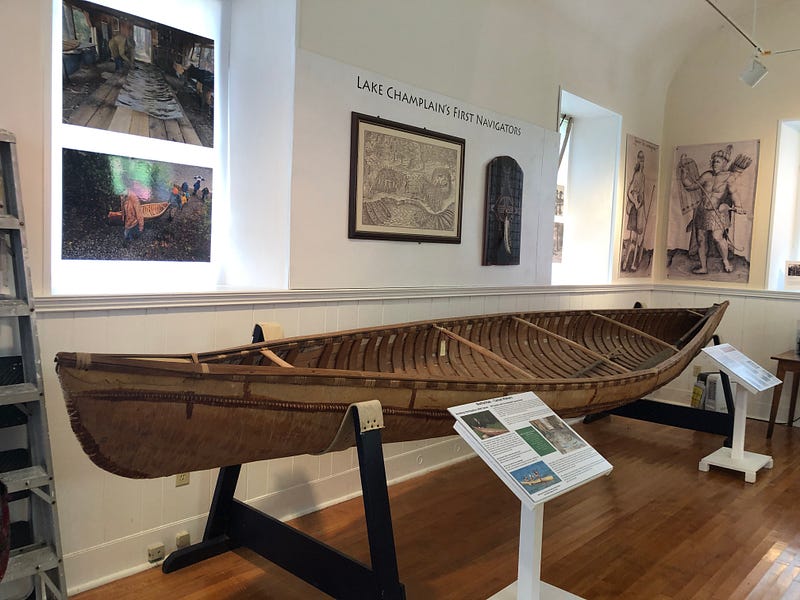
With many Vermont Abenaki under such an existential attack, the time did not seem at all right to attempt to discuss possible Abenaki stonework. I did enjoy some storytelling by Chief Don Stevens and some of the museum’s installations, but the entire event was subdued and attendance seemed diminished a bit by the situation.
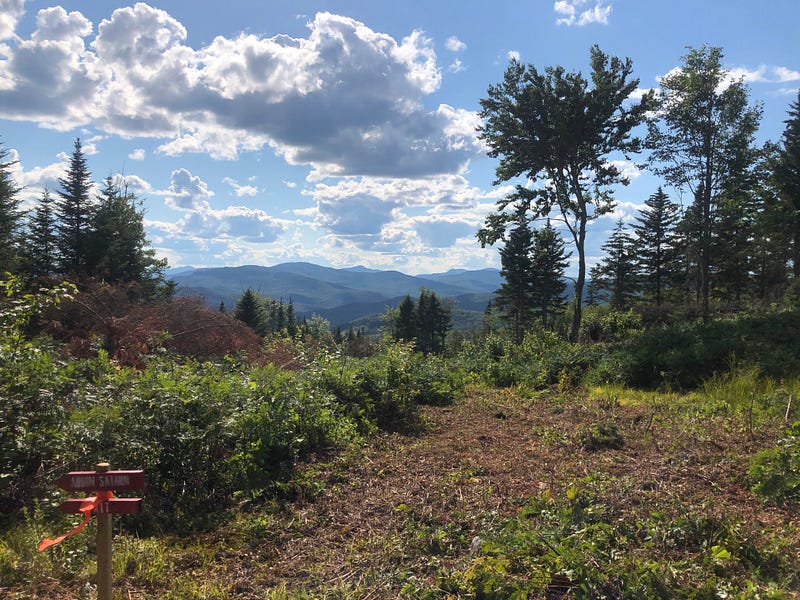
July
On July 4th, my Facebook Group Ancient Stone Mysteries of New England surpassed 10,000 Members. I never expected the group to take off like this!
Amanda and I also headed to Gates Pond on the 4th, to see some of the stonework I’d found there on past visits. I shared some of the photos and videos from the visit with the Group’s members.
Meanwhile, the New England Antiquities Research Association — NEARA — had grown interested in Dan Everett’s place in Rumford, Maine. Dan had been contacting folks around New England about his site, and NEARA President Harvey Buford had taken an interest. I’d been in touch with Harvey as well. I’m a NEARA Member, and had sent NEARA’s Terry Deveau my story on Dan’s site back in May for possible inclusion in the NEARA newsletter TRANSIT or the association’s Journal. But Terry was no longer putting the publications together, so he’d had me send the story to Harvey.
Harvey asked if I’d be willing to co-host a NEARA Field Trip to Dan’s site in mid-July, and I’d agreed. Amanda joined me up in Rumford, Maine, and we headed up to the mountainside to see Dan and meet Harvey and his wife, Dyane Plunkett, NEARA’s Treasurer and Rhode Island State Coordinator, whom I knew from Facebook. It was nice to meet Harvey and Dyane in person.

The NEARA Field Trip was a success, and many involved were impressed by the site. I found that co-hosting meant I didn’t have the chance to shoot much footage or take very many pictures. Luckily, Amanda did shoot some photos, so while I don’t have a lot, there is some documentation of the Field Trip, though without footage, I couldn’t put together a video presentation.
Eventually, my article on my first trip to the site appeared as the cover story of the one NEARA TRANSIT issue released this year, in September, and my piece on the NEARA Field Trip appeared in place of the Maine State Coordinator’s Report, within.
Toward month’s end, I made my way back out to Williston, Vermont, to the Oak View Hill Country Park. There were “stone walls” on the hiking trails map, so I was fairly certain I’d at least see something on my visit.
The first feature I found was a clearly disturbed and dispersed boulder feature on the hearest hilltop. The stones were curiously shaped. A nearby possibly ceremonial small stone ring on exposed bedrock had seen attempts to use it as a firepit. With clear views to Mount Mansfield and Camel’s Hump, this ring had potential alignments with the sunrise over Camel’s Hump on the Equinox.
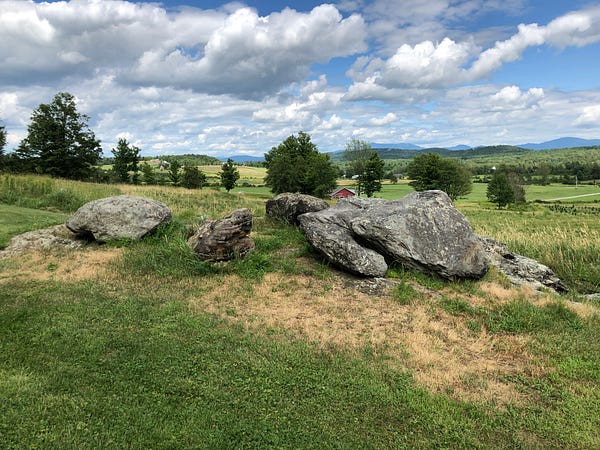
Beyond that hill, the first “stone wall” I found was actually pretty educational. The “stone wall” began in pastureland, and was mounded and made up of piled-up, rounded stones. It was an obvious product of field clearing.
As I walked towards the back of the pasture, the land began to rise uphill into an old sugarbush — and the actual stone row emerged from beneath what had been field cleared stones piled against it in the pastureland.
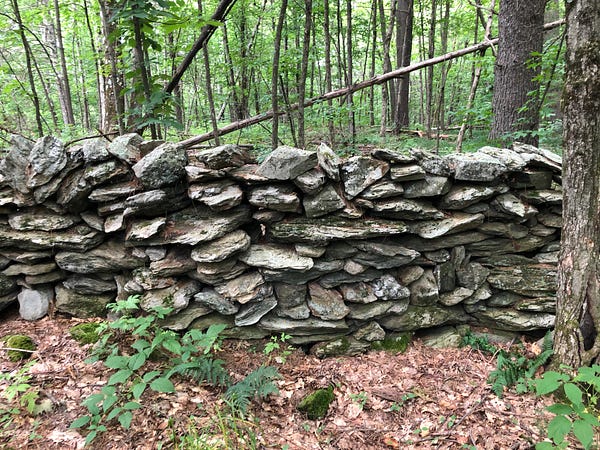
The actual stone row was made up of much more angular stones, and began to present possible Indigenous Effigy Forms as I walked further uphill. Towards the top of the hill, the effigy work became more pronounced and intricate. It didn’t appear that the hilltop stonework had seen the same alterations as those further downhill. Over the crest of the hill, the stone row dropped down a ledge and ended at its base with a tail-like construction.
There was another stone row and some possible Wing-Stones there as well, but this first stone row was a beautiful example of adaptation over time. I not only made a video presentation on the entire visit, Experiencing Possible Serpent Effigy Rows On Public Trails on Private Land in Williston, Vermont: https://youtu.be/SoTUTa_wqrU, I also made a shortened version of the stone row walk along, to illustrate the stages of adaptation, which I shared on Substack, Six Minute (Condensed) Stone Row Walk Along — From Field Clearing to Possible Effigy Row in Williston, Vermont: https://mikeluoma.substack.com/p/six-minute-condensed-stone-row-walk.

August
Much of August grew too hot and humid for stone site explorations. With much of New England’s stonework now overgrown by summer brush, there wasn’t enough to see in most places to make dealing with the high temperatures worth the effort.
The extent of my August stone site investigations involved a day trip to southwestern Vermont to visit Castelton University in the morning and Taconic Mountains Ramble State Park in Hubbardton in th afternoon.
Castleton University used to be Castleton State College. The late Professor Warren L. Cook hosted the famous Ancient Vermont symposium there back in October 1977, which looms large in the history of Vermont Stone Site investigations and in New England.
There is still an Ancient Vermont Exhibit at the Calvin Coolidge Library at what is now Castleton University featuring many photos by Warren Dexter and some stone artifacts. The library also features castings by Barry Fell in a glass display case.
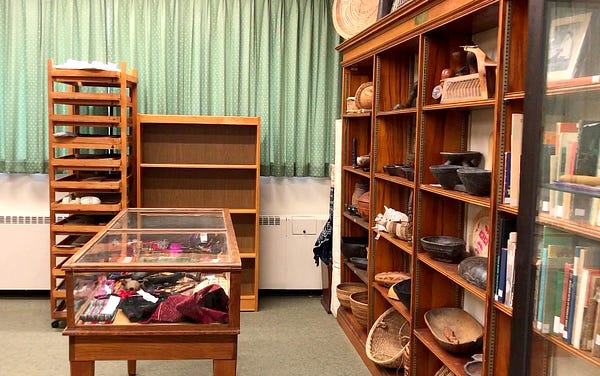
Librarian Michele Perry was kind enough to assist me in seeing some additional material, some of Warren L. Cook’s papers and a wooden tray file of more of Barry Fell’s castings, which she said had been recently rediscovered. The experience was akin to opening a time capsule, giving me a little sense of what it must have been like discovering stone sites in Vermont in the 1970's.
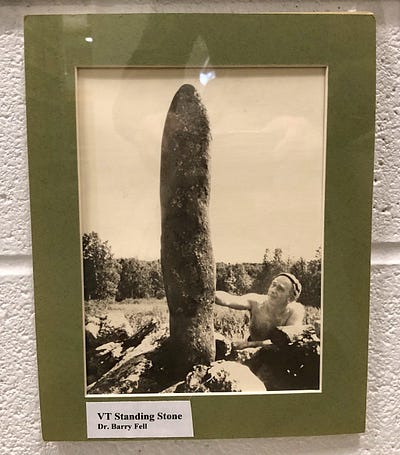
I decided to cover the visit in my video presentations as one of my Ancient Stone Mysteries of New England Videos, Visiting “Ancient Vermont”: https://youtu.be/Jw9pqm0keV8.
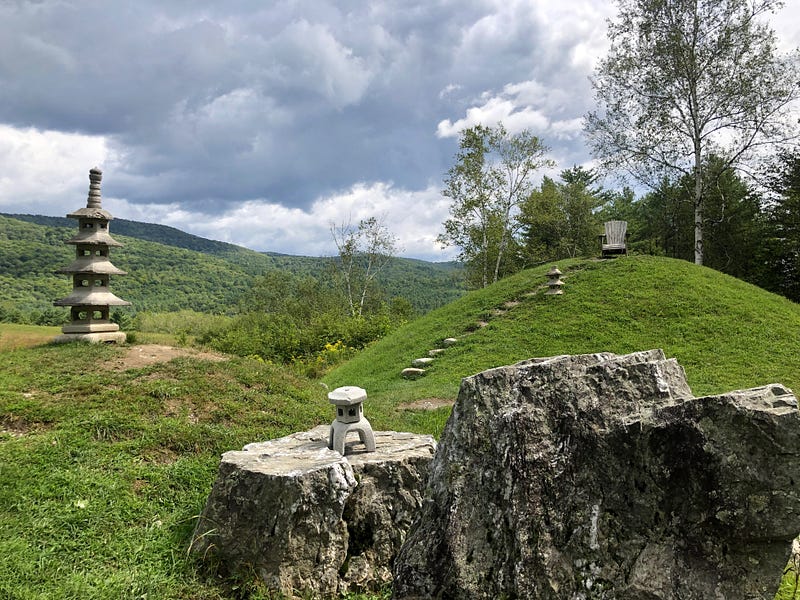
Up the road in Hubbardton, I spent that afternoon checking out Taconic Mountains Ramble State Park. Fellow Vermont Stone Site Investigator Josh Smart had asked if I’d ever seen the Mounds at Taconic Mountains Ramble State Park. I had not. He hadn’t either — he’d come across it online.
I’d gone out to see Mounds in the midwest to be able to better judge earthworks here in New England. When I saw some initial pictures of Taconic Mountains Ramble State Park, I had to go see for myself.
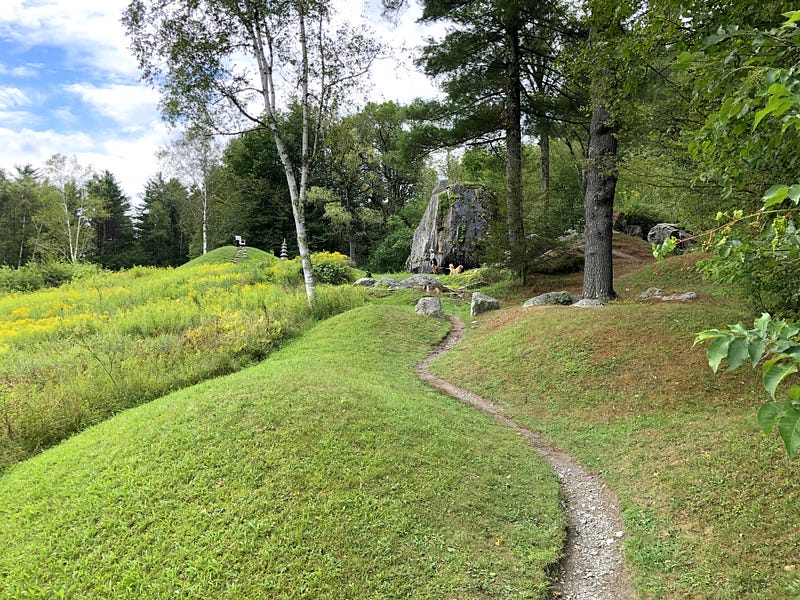
A little research revealed the property had belonged to a retired filmmaker, Carson “Kit” Davidson, and his wife Margaret “Mickie” Davidson, who donated it to the state as a park just before Kit died in 2017. Kit built a Japanese Garden here, where the mounds are, and I believe he built them or had them built.
It’s a fascinating space, but too altered to reveal anything pre-1966 when the Davidsons acquired the property. These are certainly not Indigenous Mounds. But it is a curious space, if culturally a bit alien to the Vermont Mountains.
The Davidsons created the trail system here and invited local folk to hike as they liked, sharing the land with their neighbors over the years. They gave it to the State of Vermont expressly to continue to preserve it and share it.
The Big Backyard feeling of the space, a tamed wilderness playground, if you will, didn’t lead me to think I’d see much else as far as Indigenous work, though there was an intriguing stone assemblage on “Moot Point” — you could tell names of trails and places were the work of a creative mind.
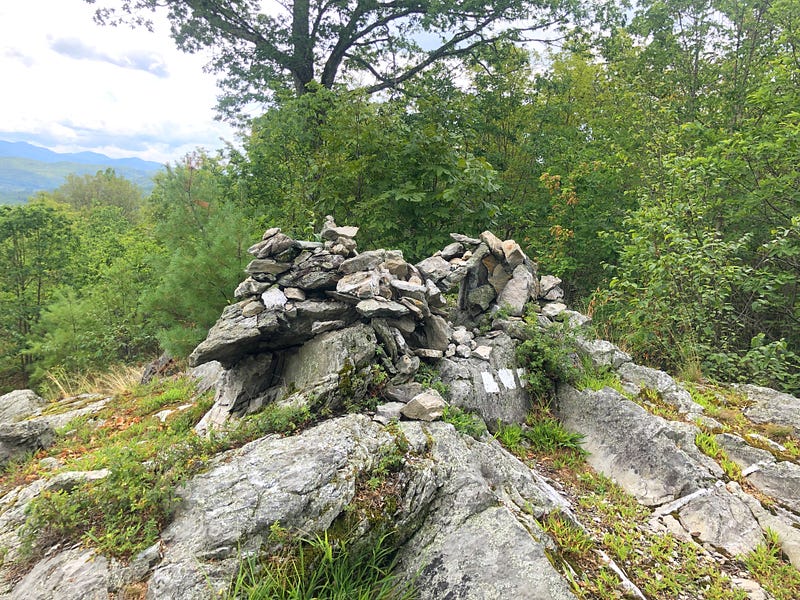
Though there wasn’t much stonework, the park was certainly an experience, and worth a video presentation, Experiencing A Japanese Garden & More in Taconic Mountains Ramble State Park in Hubbardton, Vermont: https://youtu.be/1SxC3ppxpnE.
A landholder in Southeastern Vermont posted photos in the Facebook Group of some very curious-appearing stone assemblages on his property, looking for explanations. Art Camp shared pictures of cairn-like assemblages and some stone rows, and I reached out with my suggestions as to what he might have on his land — and asked if I could come and see the features. But heat and my traveling would keep me from seeing the site until the Autumnal Equinox in September.
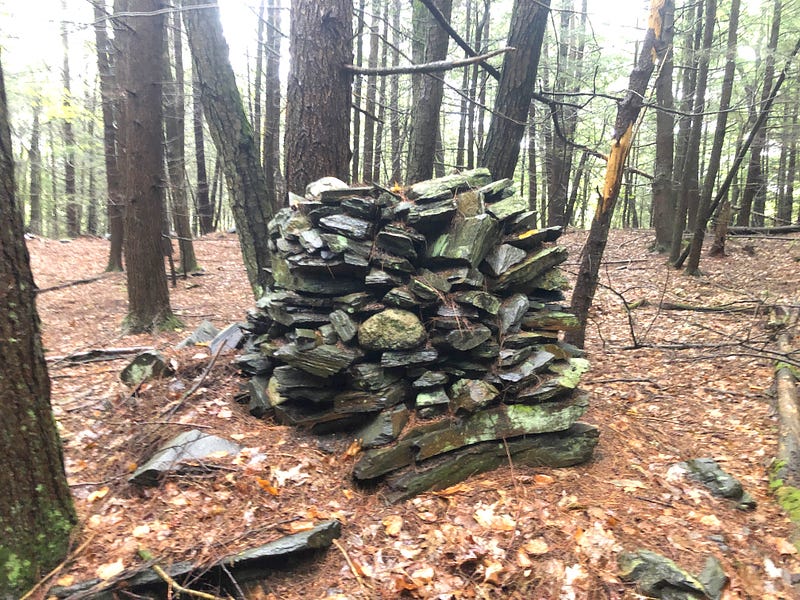
September
We set out Labor Day Weekend to explore an area near Berlin, Massachusett’s Forty Caves we hadn’t yet seen, where Amanda had spotted a huge glacial erratic and curiously shaped surrounding stones.
Glacial Erratics, Exfoliation, Erosion… Nature, including Glaciers, can do a number on rock and stones. And humankind can do quite a lot with stonework, too. But many geological suppositions of what occurred naturally and what was the work of human hands, especially in Northeastern North America, were made in the nineteenth and twentieth century at a time when the “Pristine Myth” of an untouched wilderness dominated academic thinking.
They may have given Nature — often code for “God” at the time — a little too much credit. And credited local Indigenous not at all for any work they may have done. The huge boulder at this site looked as if it could have been altered by human hands, as did low ridges around it.
There’s growing acknowledgement that Indigenous Peoples in the Northeast worked with stone in ritual settings creating Ceremonial Stone Landscapes, as the USET (United South and Eastern Tribes) Resolutions call them. Much of the stonework in New England assumed to be Colonial or later now appears to be much, much older, and of Indigenous origins.
There’s also potentially larger scale work, Possible Large-Scale Great Serpent Stonework, which includes repeated themes and motifs in the features such as Wing-Shaped or Fin-Shaped Stones added to embellish emerging bedrock ridges and ledges. I’ve found this work in Vermont and Massachusetts, including here around this huge Glacial Erratic. These places where bedrock breaks through could have been seen as transitional zones between worlds, with the stones added to long low ridges to evoke Great Serpents said to live in the Under World.
These ancient Indigenous people possessed imaginations, just as we do, and the will and skill to alter their environments and bring out from the stone that which it seemed to evoke. They were not living in some primitive sub-human state of proto-intelligence. They were people, just like you and me, living complex lives and — maybe — seeing Great Serpents in the Stones.
Or, perhaps, Fish.
After checking out the immediate area around the erratic, we wandered a bit further into the woods and came across an amazing Fish Effigy. I’m usually pretty cautious, using “possible” and “potential” when describing stone features and things, and much of what lies around the huge boulder would fall into the highly speculative category. But this Fish Effigy left me with little doubt. I came across it from the back, so I saw a fully featured Tail Stone first, which appeared to have been clearly fashioned to represent a fish form. The only question might be “by whom?”
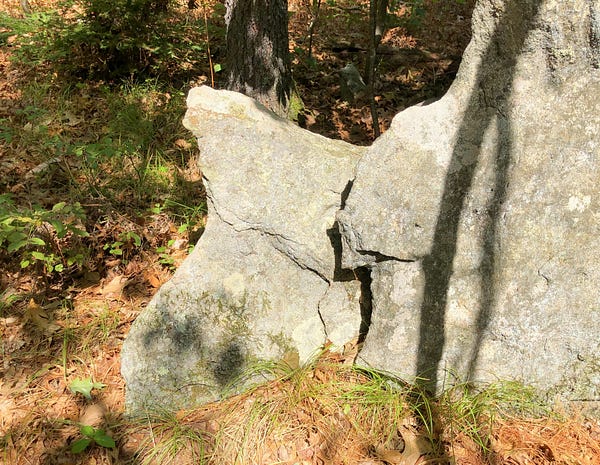
I shared photos and some footage in my Facebook Group, but wouldn’t put a full video presentation together until after we visited another, different Berlin, Massachusetts site later in the month.
The next weekend I was back in Vermont, and headed out to another Williston, Vermont site a little further east than the others, but still close to Five Tree Hill Country Park, with the unglamourous moniker of Mud Pond Country Park — right next to Mud Pond Conservation Area. I’d come back to see what features the Conservation Area might hold in early October.

I found possible Stone Effigy Rows in Mud Pond Country Park, and an intriguing looking Stone Mound as well, but the features were worse for public wear — especially the Mound — due to the fact mountain bikers have free run of the Country Park. The Mound has a groove worn into to it by mountain bikers using it for recreation. It’s not deliberate nor malicious, just casual destruction. But this is a good example of why it’s so important to recognize stone assemblages for Indigenous Stone Structures and to create public awareness.
You don’t realize how long Vermont is, north to south, until you have to travel almost the length of the state from almost the northwest corner down to almost the southeast corner. Art Camp’s Southeastern Vermont site was closer to my Mom and Amanda in Massachusetts than it was to me. Decided to go the rest of the way to see them after my day at Art’s and spent the weekend in Massachusetts.
Coincidental timing placed me at Art’s in Southeastern Vermont on the Autumnal Equinox — September 22nd, this year. The stonework was impressive, potentially home to an extensive Ceremonial Stone Landscape. Several potential Serpent Effigy Rows ran along low rounded ridges that encircled an oval-shaped hollow. Likely Sacred Stone Assemblages (akin to European cairns) still perched in the hollow, though they showed wear and tear from the ravages of time and people.
Two of the Stone Assemblages sat nearly together in the middle of the hollow towards its southern end. An abbreviated Effigy Row curved along the base of a ridge nearby. Several fragments of stone rows surrounded the hollow. Towards the Northern end, a Direction or Effigy Stone pointed up the rounded ridge to a Third Stone Assemblage. From downhill, looking up, the Directional or Effigy Stone appeared to have the potential for a Summer Solstice Sunset Alignment. The third assemblage appeared to have been degraded, and to be missing stones.
There are many more stone rows extending off of this hollow. One which ran toward the northeast rose on a hill cleared beneath power transmission lines and displayed curious possible effigy forms. Near the top of the hill, a single flat, fin-shaped stone was propped in place. Perhaps a sort of Dorsal Fin on the back of this Great Serpent.
The horizon beyond it was obscured by trees, so I couldn’t look for specific solar alignments, but the SunSeeker App showed me if I’d been standing there a few hours earlier as the sun rose, it would have risen over this rock and over the site beyond. There was the potential for an Autumnal Equinox Sunrise Alignment.
Though this is a private site not open to the public and I can’t reveal the location, I would return to lead a NEARA Field Trip to the site a little over a month later. And I published a piece on the site here on Medium:
A New Look At Old Vermont Stonework
Investigating A Possible Ceremonial Stone Landscape In Southeastern Vermontglowinthedarkradio.medium.com
For this site, I not only put together a video presentation, Experiencing a Newly Discovered Possible Ceremonial Stone Landscape in Southeastern Vermont: https://youtu.be/qrb9pvLHvzk, I also shared three clips of Raw Video footage on Substack (which featured new Raw Video intros and outros), Raw Video — Newly Discovered Possible Ceremonial Stone Landscape — Stone Effigy Row: https://mikeluoma.substack.com/p/raw-video-newly-discovered-possible, Raw Video — Newly Discovered Possible Ceremonial Stone Landscape — Stone Assemblages: https://mikeluoma.substack.com/p/raw-video-newly-discovered-possible-390, and Raw Video — Newly Discovered Possible Ceremonial Stone Landscape — Potential Equinox Standing Stone: https://mikeluoma.substack.com/p/raw-video-newly-discovered-possible-5cd.
The next day, in Massachusetts, Amanda led us to a site off of Linden Street near Berlin’s Mount Pisgah, where we found some remarkable potential Effigy rows and what appeared to be a Boulder Headed Serpent Effigy form. I documented the stone rows with some long walk-alongs and shot a bunch of photos and footage of the Boulder Serpent. We didn’t go far, but still managed to spend hours checking out the abundant stonework in that location.
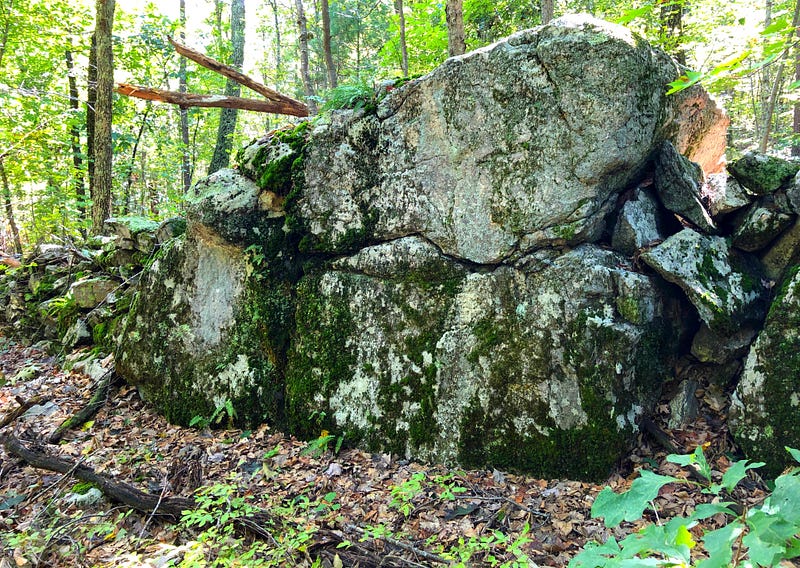
Combining this Berlin site visit with the one earlier in the month, I created a single video presentation, Experiencing Possible Stone Effigy Work in Berlin Massachusetts: https://youtu.be/sjP5c-pUwUs. I used Substack to share some of the Stone Row walk-alongs from this visit, Raw Video — Berlin Stone Row Walk-Alongs, Part One: https://mikeluoma.substack.com/p/raw-video-berlin-stone-row-walk-alongs, Another Berlin Stone Row Walk-Along: https://mikeluoma.substack.com/p/another-berlin-stone-row-walk-along, and Third Berlin, Massachusetts Stone Row Walk-Along — 25+ Minutes of Raw Video: https://mikeluoma.substack.com/p/third-berlin-massachusetts-stone. I wasn’t sure Substack would host that long a video, so it was actually posted to YouTube: https://youtu.be/gvuJybAnPYk.
October
I began the month of October, near the peak of foliage season, by heading back to the Mud Pond area, visiting the Mud Pond Conservation Area in Williston, Vermont, across the road from Mud Pond Country Park.
Mud Pond belied its ugly name and was quite stunning with the changing fall colors. I found an old stone row which ran uphill on the western side of the pond and shot a walk-along video as I climbed the hill. There was also an extensive wooden boardwalk on the pond’s northwestern side, and as this was an in-and-out trail (as opposed to a loop), I also shot a long video of my walk back along this interesting wooden structure. Both videos were posted to Facebook when I returned home, the wooden boardwalk to my own feed, and the Stone Row walk-along to the Ancient Stone Mysteries of New England Facebook Group.
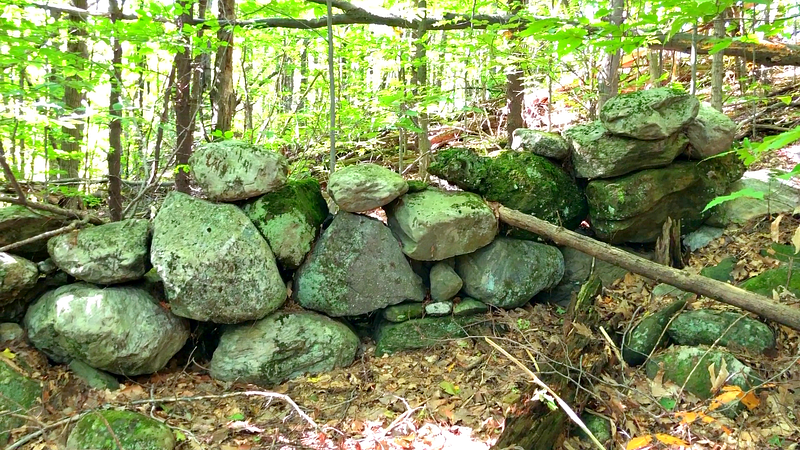
Having now been through both the Mud Pond Country Park and Mud Pond Conservation Area, I covered both in the video presentation Experiencing Curious Stonework Near Mud Pond in Williston, Vermont: https://youtu.be/8HZK23eaOGs. I shared footage on Substack as well, A Stone Row Near Mud Pond: https://mikeluoma.substack.com/p/a-stone-row-near-mud-pond and Possible Serpent Effigy Stone Row Walk-Along: https://mikeluoma.substack.com/p/possible-serpent-effigy-stone-row.
In the middle of the month, it was back over to Maine, back to Dan’s Aroon Satarn site in Rumford, this time for a NEARA Research Trip. NEARA were assisting Dan by drawing soil samples from beneath some of the possible Stone Prayers on his site for OSL Dating — Optically Stimulated Luminescence Dating. Archaeologist Curtiss Hoffman, author of 2018’s Stone Prayers, was invited to join in the research. I’d been reporting possible stone sites to Curt ever since I’d read his book, so it was very nice to finally meet and work alongside him at the Maine site.
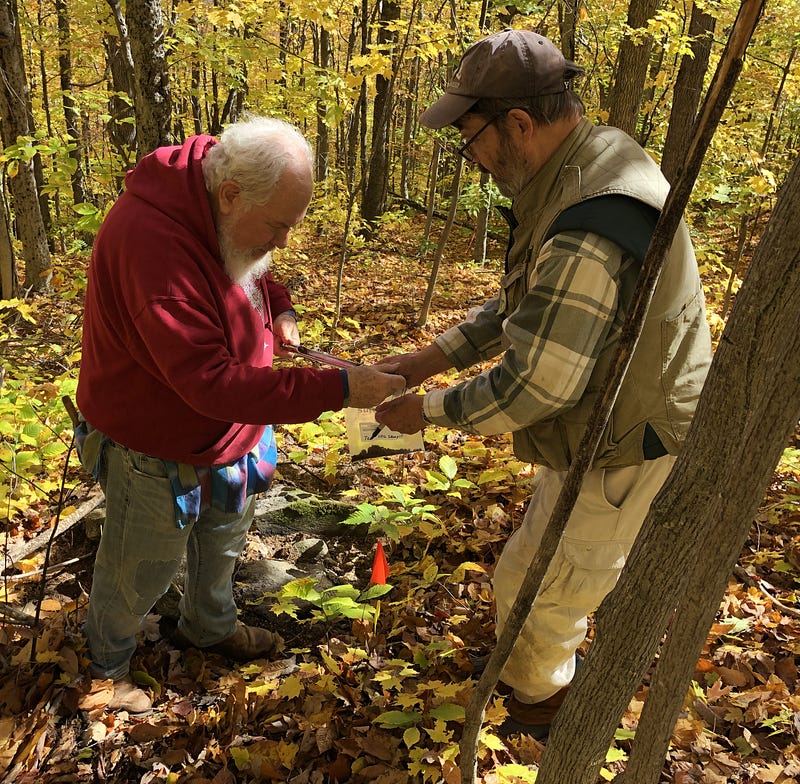
Dan had again invited me along, and Harvey encouraged my desire to document this NEARA Research Trip in video and photos. I told Harvey the Field Trip had been great, but kept me too busy to shoot photos and footage — I looked forward to covering the research process this time.
I’m not trained for the hands-on work, and don’t generally feel, personally, that I should disturb the stonework. And please remember, without the proper training, neither should you. Take only pictures, and do not disturb. I was there to chronicle the weekend and to help where I could. And I learned a great deal.
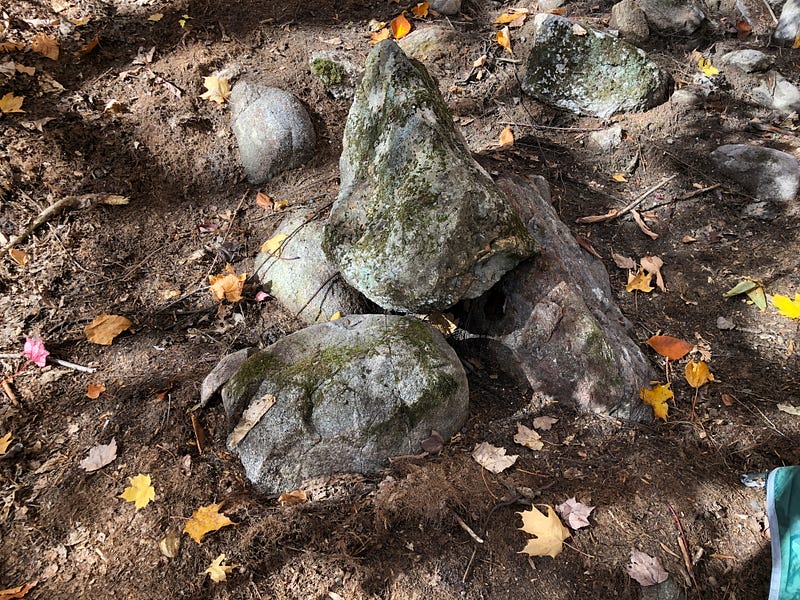
Did end up digging some control samples for one of the stone assemblages, away from the stonework itself, and filling out some fieldwork forms — which was much cooler than it might sound. That, I couldn’t document with pictures, because I was working.
The digging done next to and work around the stonework was done by trained NEARA researchers in a non-destructive way to respect and not disturb the stonework in situ, the work carefully chronicled, each step documented, as it went on.
I couldn’t shoot inside of the tent as the actual samples for OSL Testing were taken, as there’s only room for the folks gathering the sample, and no light inside the tent. The researchers use a headlight with a red or red-orange tint — lights whose frequencies won’t impact the sample.

After the trip, the samples and the rest of the work were sent off to the lab, and we now wait a few months for the testing to be completed, find out if the samples were good, and see if we get some actual dates for some of this stonework.
The landowner Dan deserves many kudos for his dogged determination to understand the stonework he’s found on his mountainside and his commitment to protect it. I’m looking forward to seeing if this first round of OSL testing yields good data, and to seeing just how old those mountainside stone assemblages might be.
I was determined to get the video done before NEARA’s Fall Conference, scheduled for the first weekend of November in Brattleboro, Vermont. Harvey had asked if I’d do a presentation on the stonework at Aroon Satarn in place of the Maine State Coordinator’s Report at the Conference, and I’d agreed. I’d never worked with PowerPoint nor ever done a Presentation like this before, so I was working on that as well as the video presentation, Experiencing a NEARA Research Trip to A Stone Site in Maine: https://youtu.be/0dYHDU7Xp04. I shared pictures and a rundown of the trip in the Facebook Group as well.
Feeling the need to get out somewhere, on the last Sunday of the month I headed to Essex’s Mathieu Town Forest, southeast of Indian Brook Reservoir Park and a little northwest of the Williston sites I’d been exploring. But even though the Forest abutted the Circumferential Highway, whose proposed construction had led to the discovery of numerous Indigenous habitation sites in this area, there were no stone features to be found in the Mathieu Town Forest in Essex, Vermont.
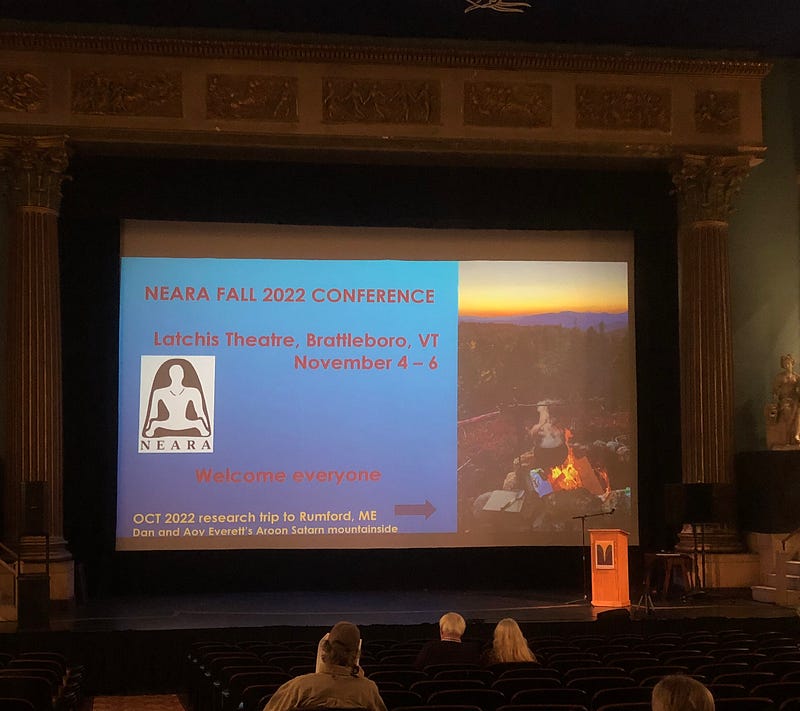
November
The first weekend in November brought the NEARA Fall 2022 Conference to the Latchis Hotel and Theatre in Brattleboro. My presentation on Aroon Satarn came in place of the Maine State Coordinator’s Report on Saturday morning. On Sunday, I led a NEARA Field Trip to Art Camp’s recently revealed site in Southeastern Vermont. Occupied with showing people the site, I wasn’t able to shoot many photos or any video footage. Amanda took photos, so there were some to share in the Facebook Group.

Since June, as I’d been exploring I’d also been working on my book. Hitting the home stretch this month, I devoted most of my spare time to completing the project, and managed to upload files for a proof copy just before the Thanksgiving Holiday.
December
Although I made a short return trip to Oak View Hill Country Park in Williston, Vermont this month, I didn’t end up shooting anything, as it was a meeting, of sorts. Joe had expressed an interest in helping out with my YouTube channel videos, so I suggested we meet at Oak View Hill. I showed him the Stone Row which displays the stages of adaptation and he got it — which was a good sign. My videos are kind of personal creative efforts, so at first I wasn’t sure how I could include someone else. But as we talked, I thought it might be good to have another videographer with me in some cases, especially when I’m checking out a site for the first time with a landowner. We’ll give that a try, see how it goes.
We were supposed to meet up with Stone Site Investigator Josh Smart at a new site in Central Vermont the next weekend, but Mother Nature intervened and dumped a bunch of snow at the site. Can’t investigate what you can’t see.
The big news for me this month was the release of my new book, Ancient Stone Mysteries of New England: Discovering Ancient History All Around Us. Over 370 pages, over 500 black and white photos and illustrations — it’s available now at Amazon, Barnes & Noble, Bookshop.org and other sites. You can find out more at http://AncientStoneMysteries.com.
I’m wrapping up this wrap-up on December 29th. Earlier today, Amanda and I checked out a new site in Boylston we’d been scouting. There was so much there, we didn’t get far down the trails. I’m still processing all that we saw, and haven’t shared much of anything yet. But I did shoot over 360 photos and videos, so more will be forthcoming.
That’s my 2022 in Stone Site Investigations! If you’d like to learn more above and beyond the linked articles and videos, I invite you to join the Facebook Group, Ancient Stone Mysteries of New England: https://www.facebook.com/groups/ancientstonemysteries.


